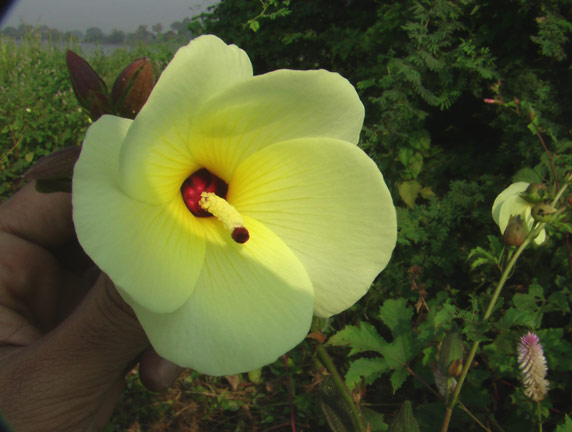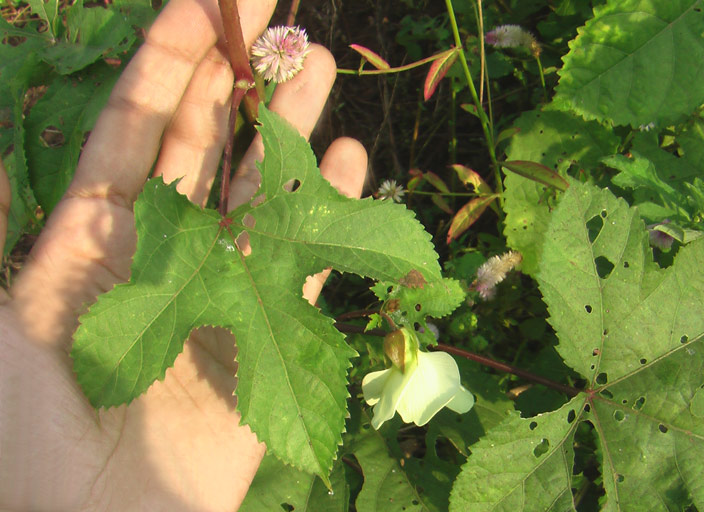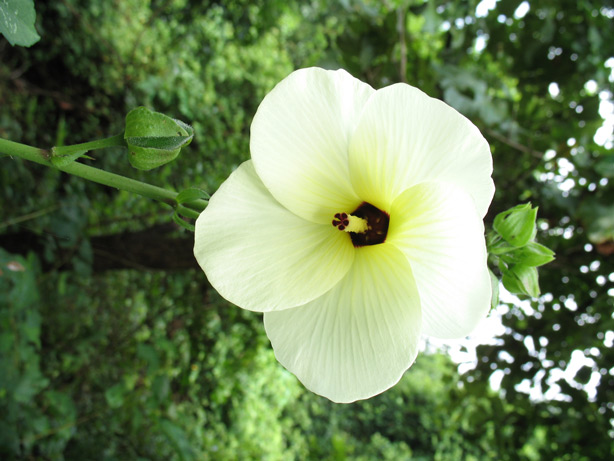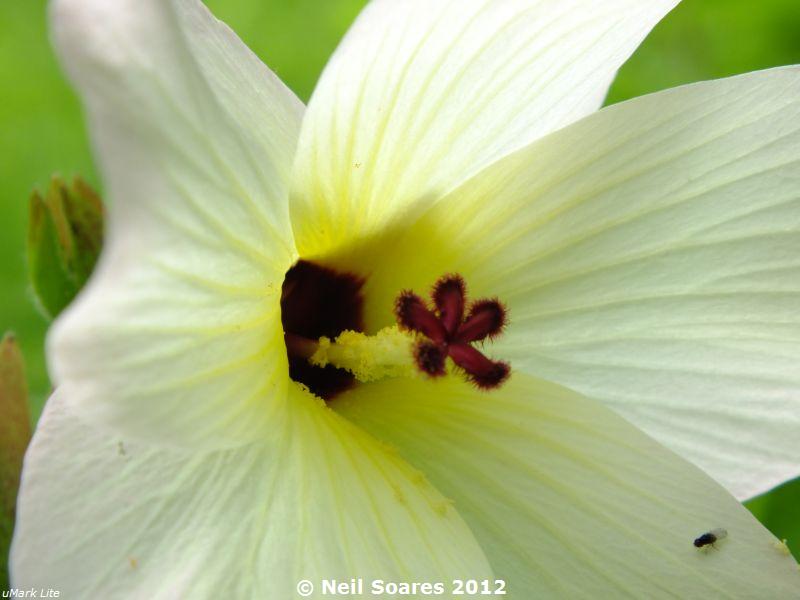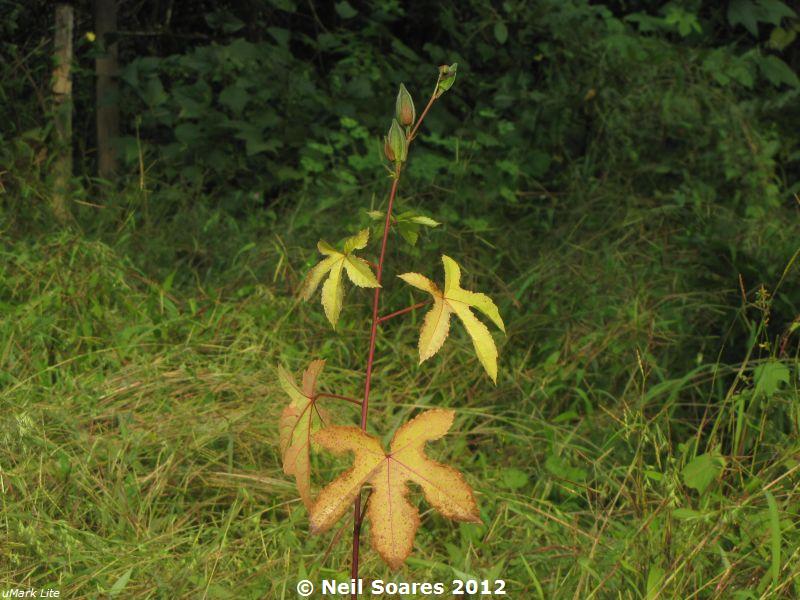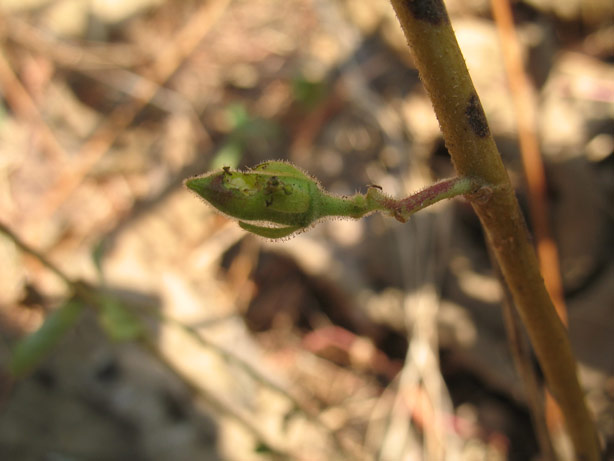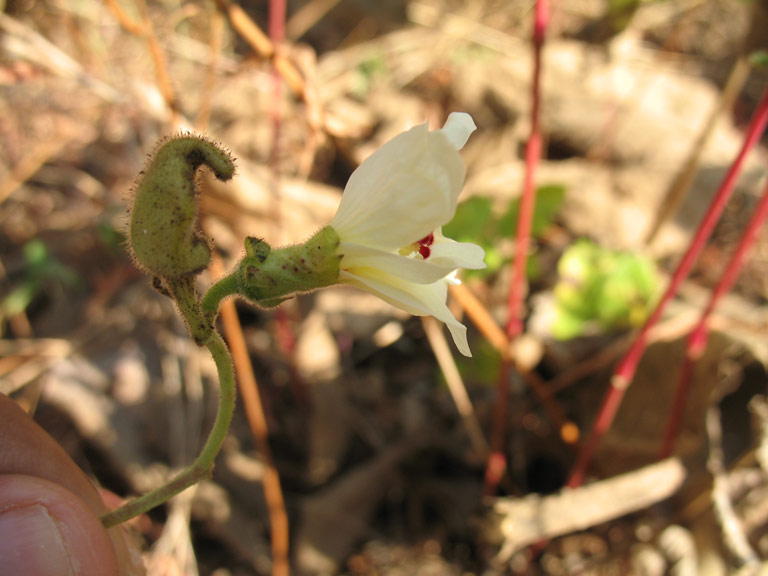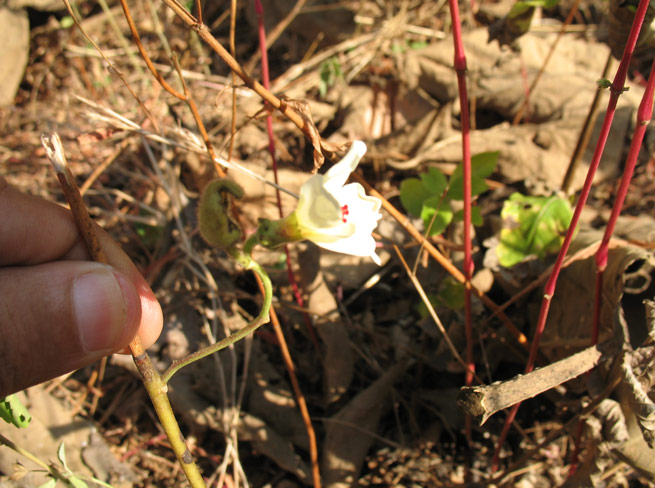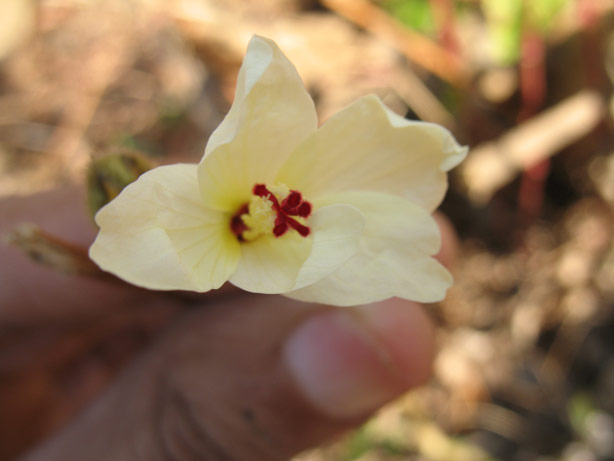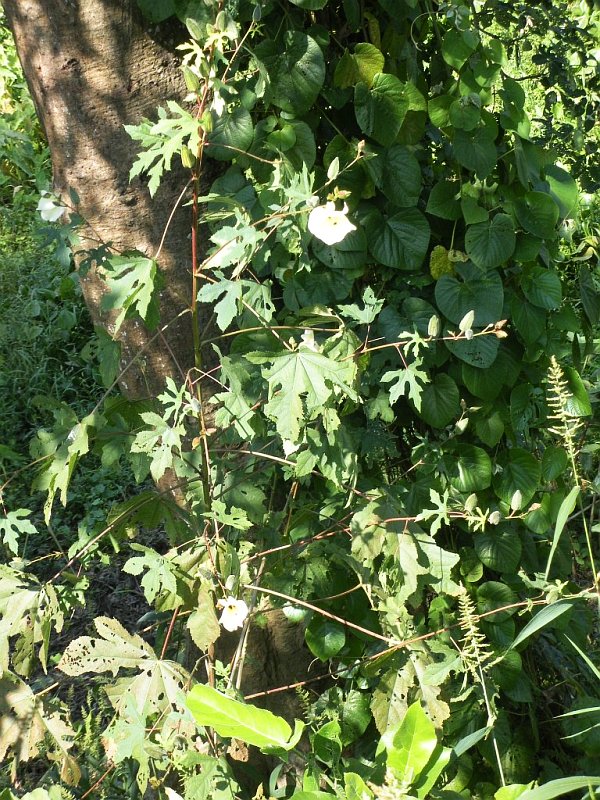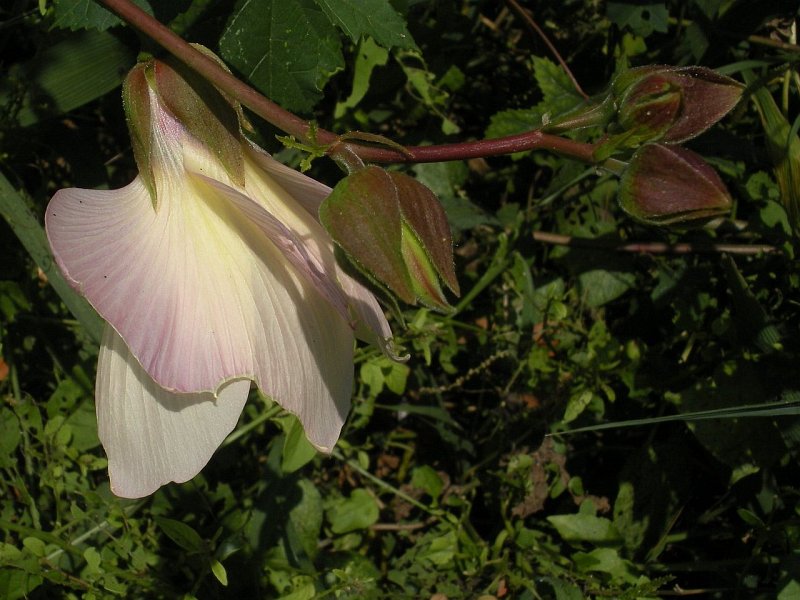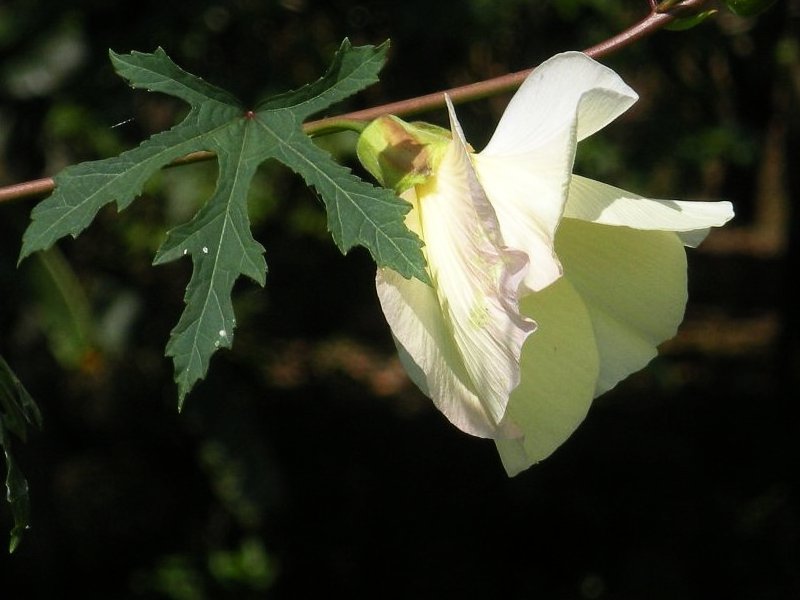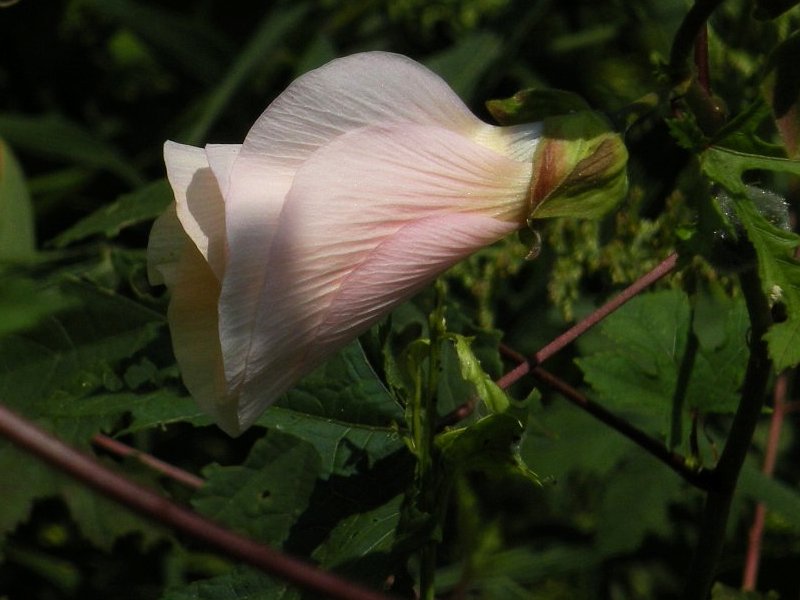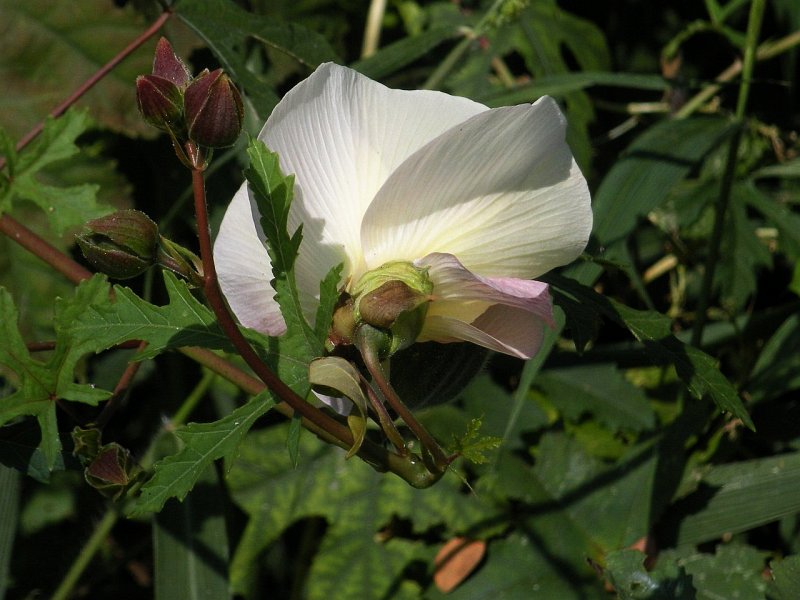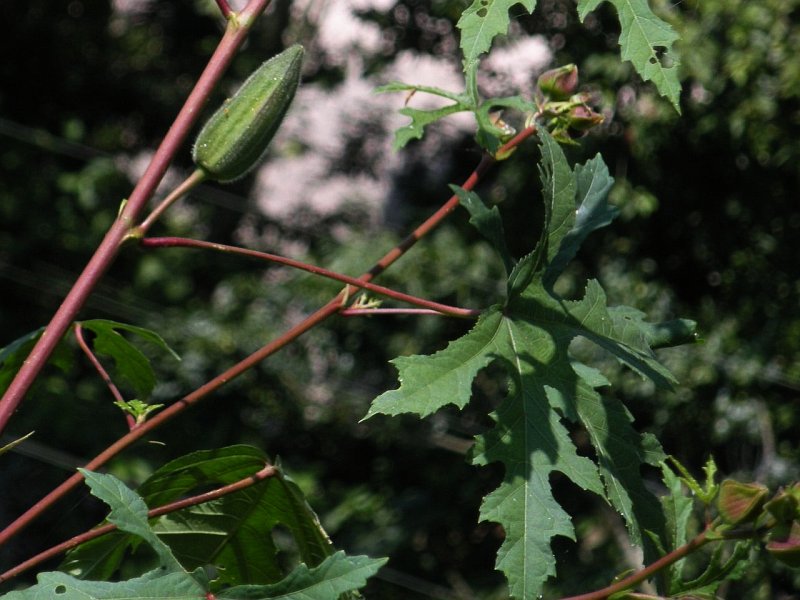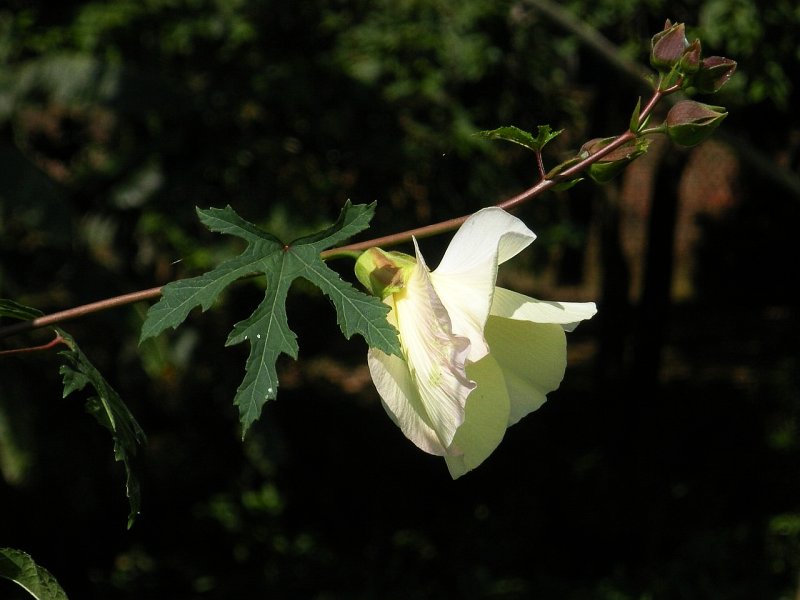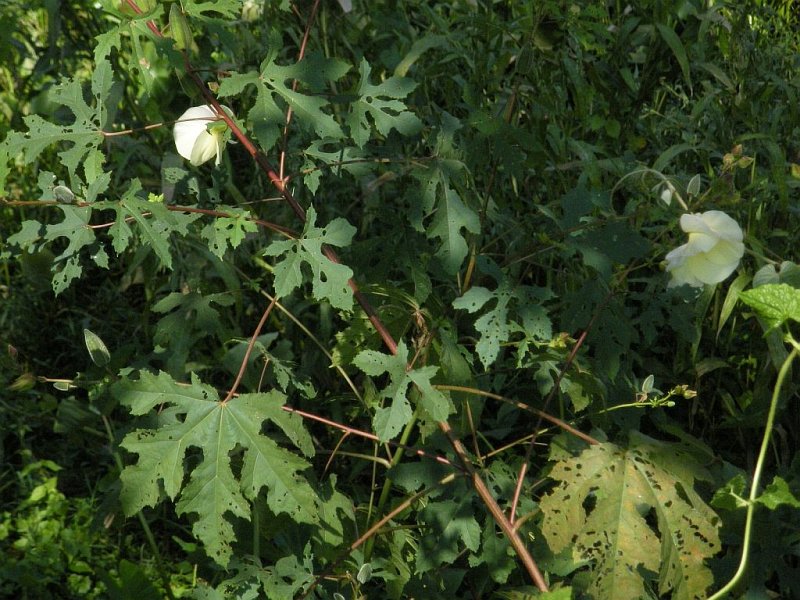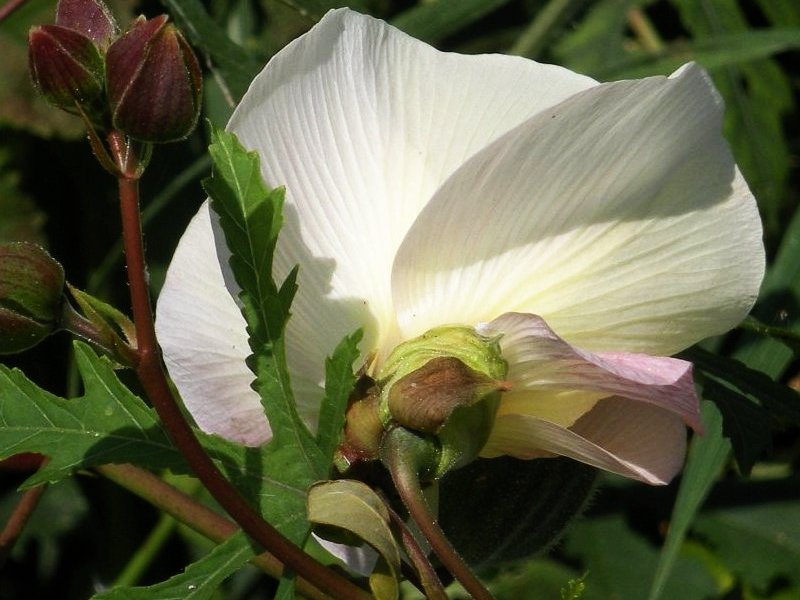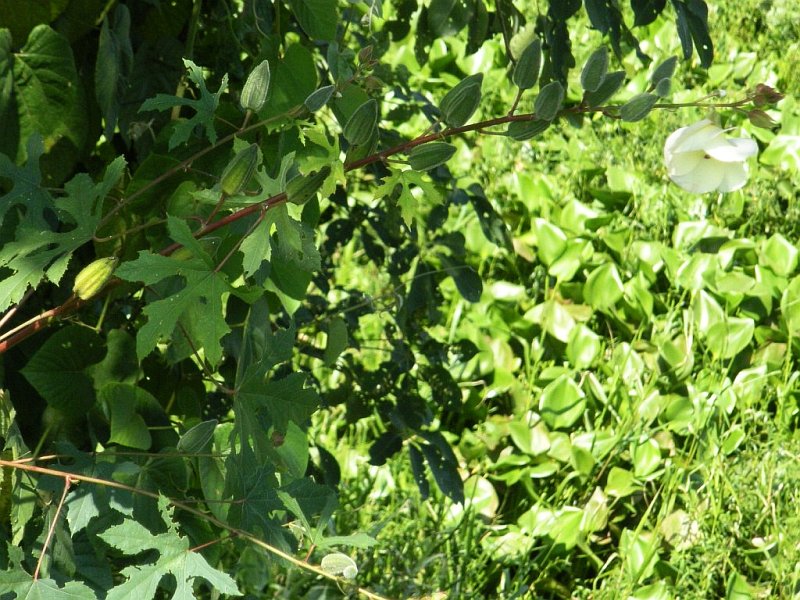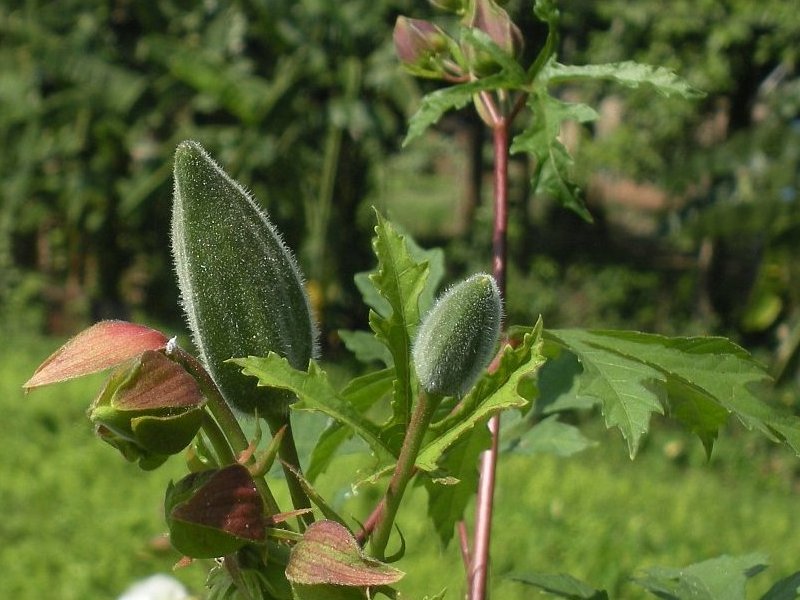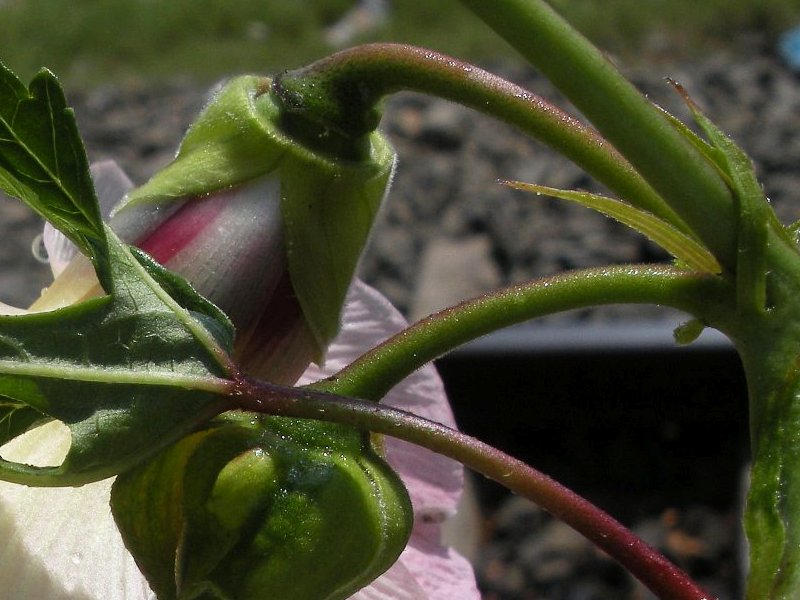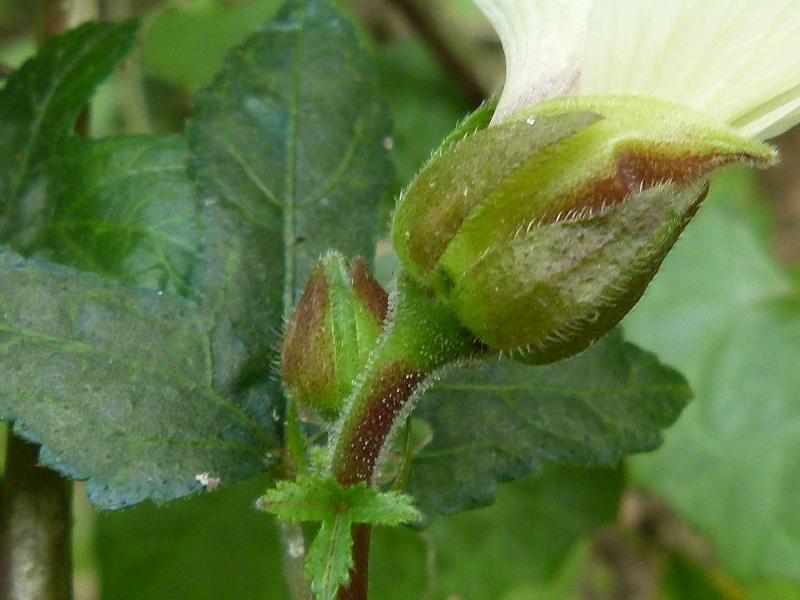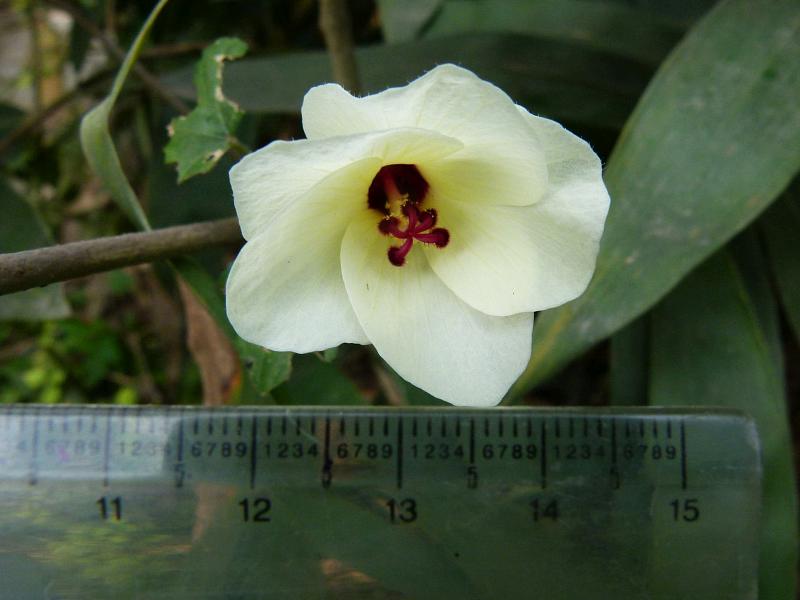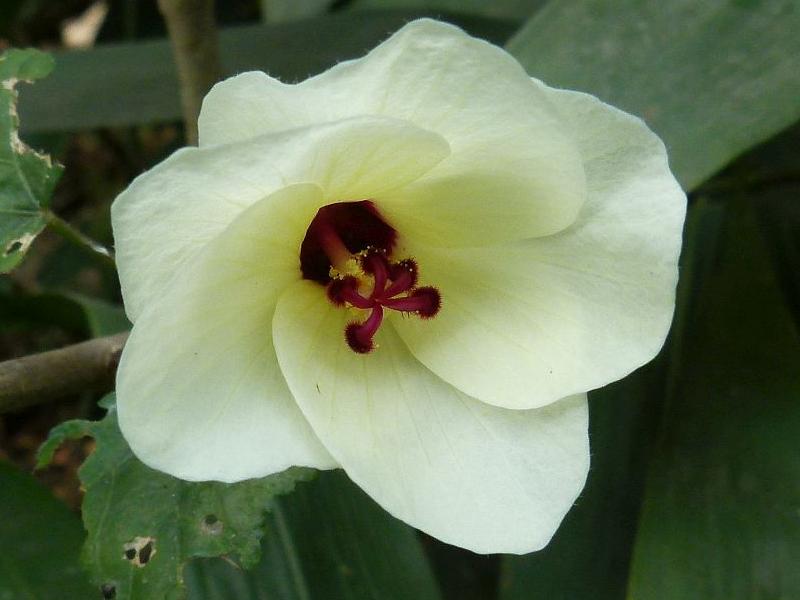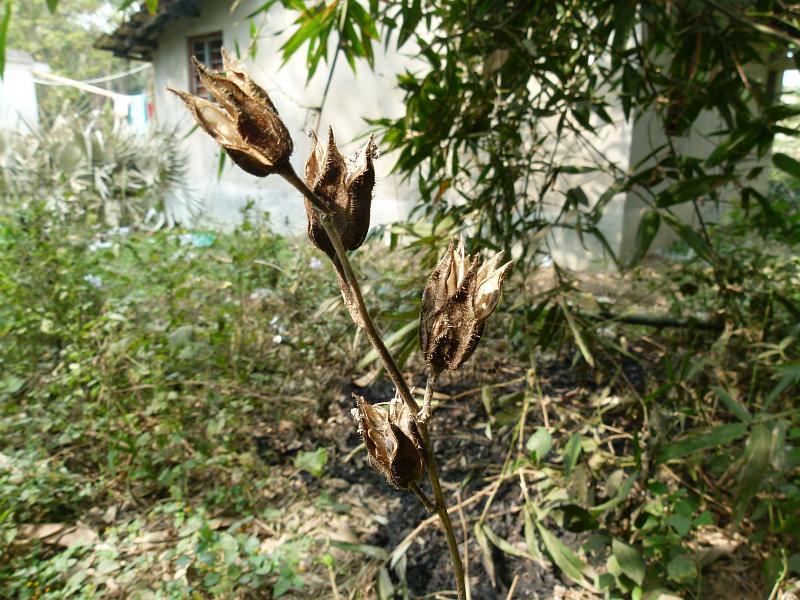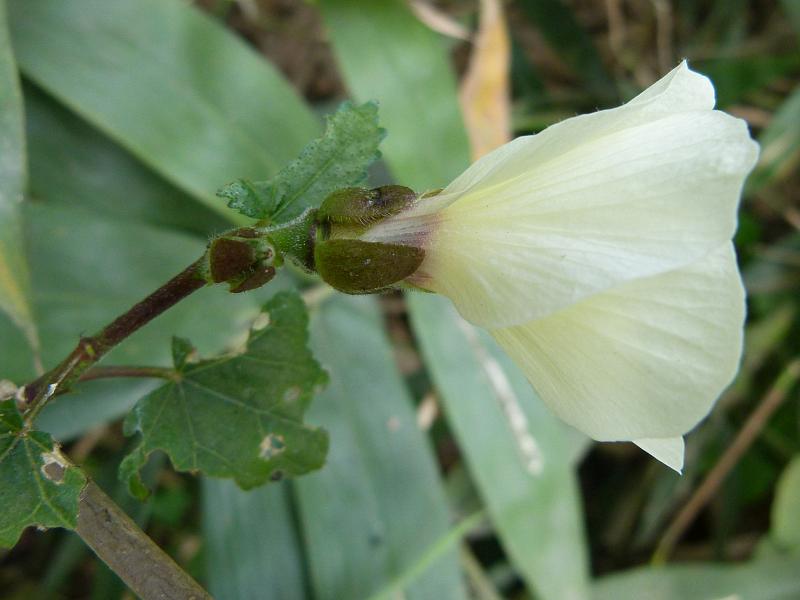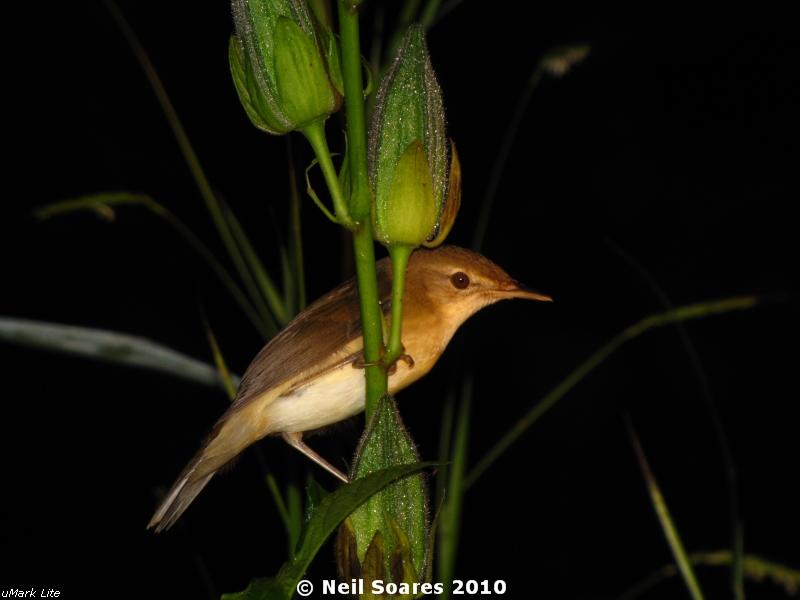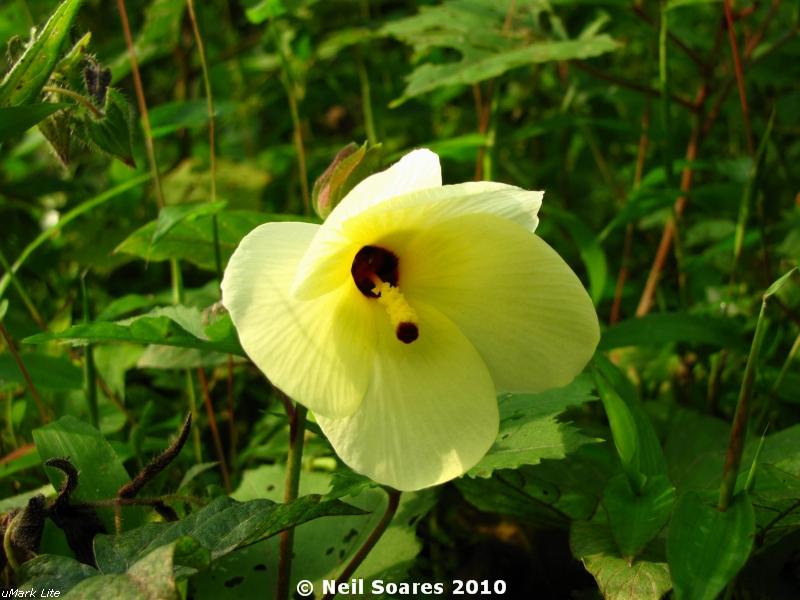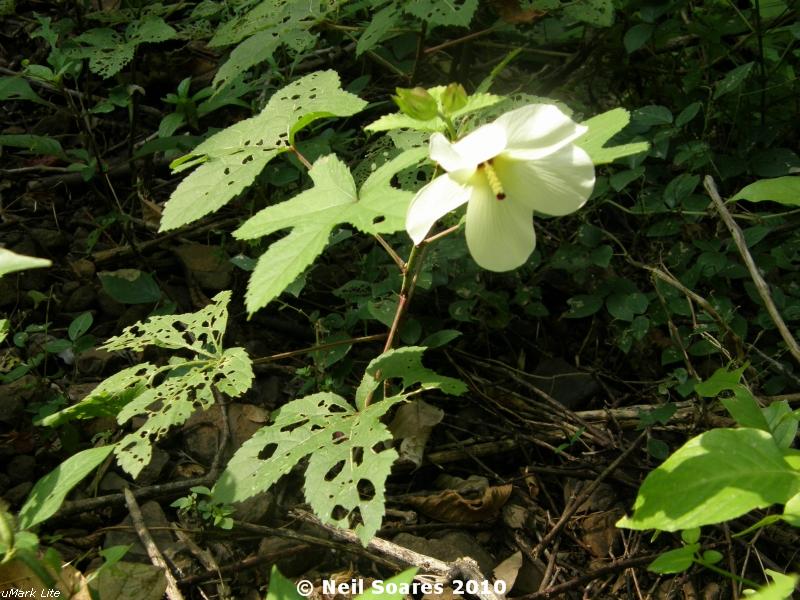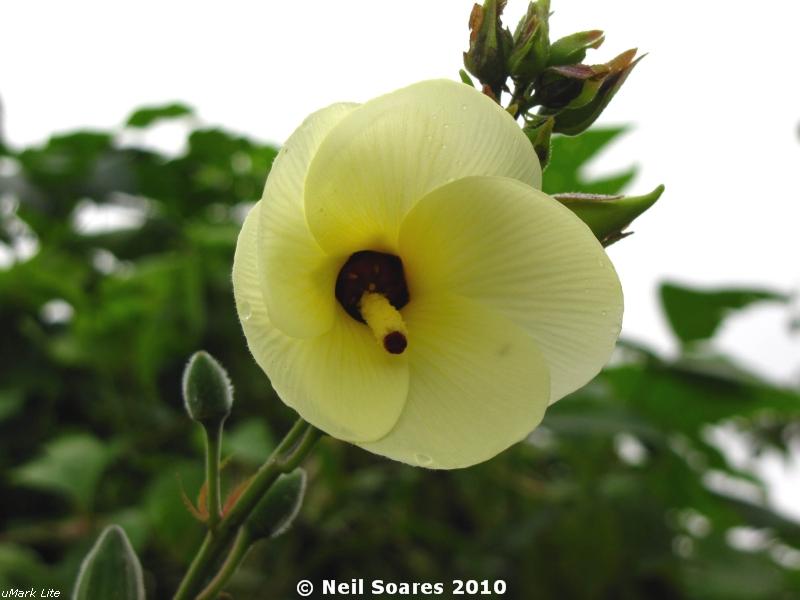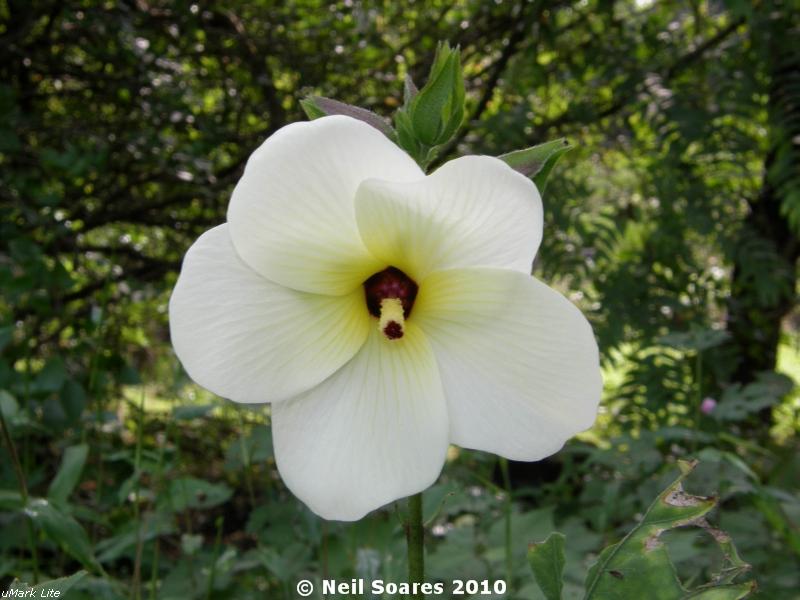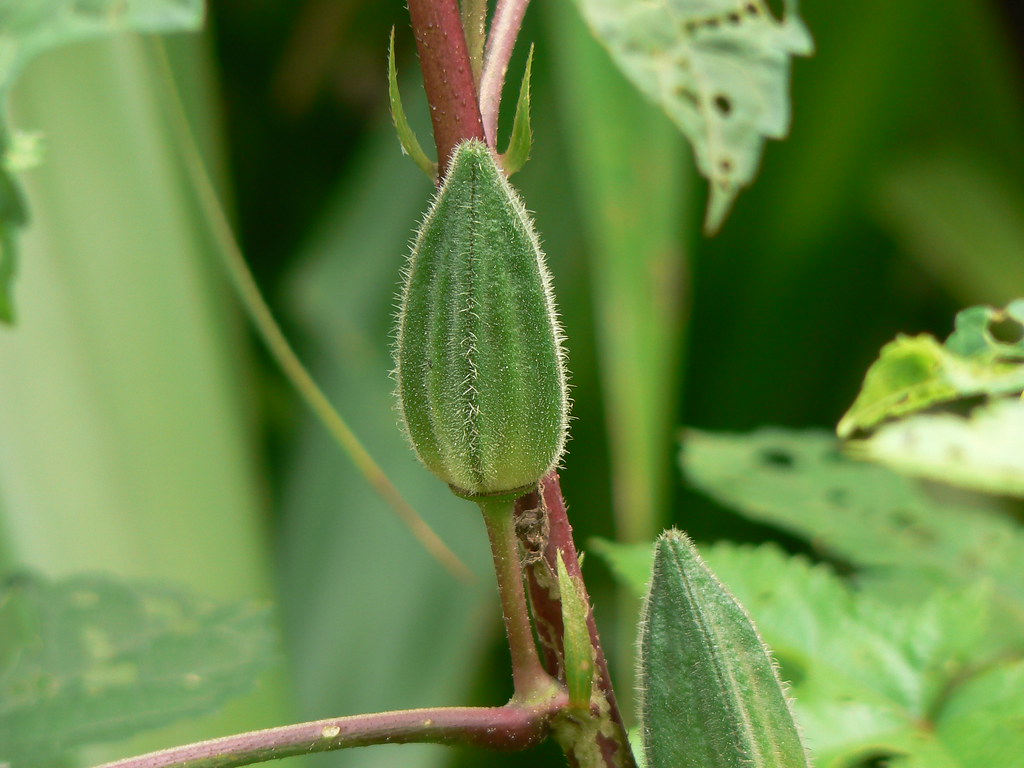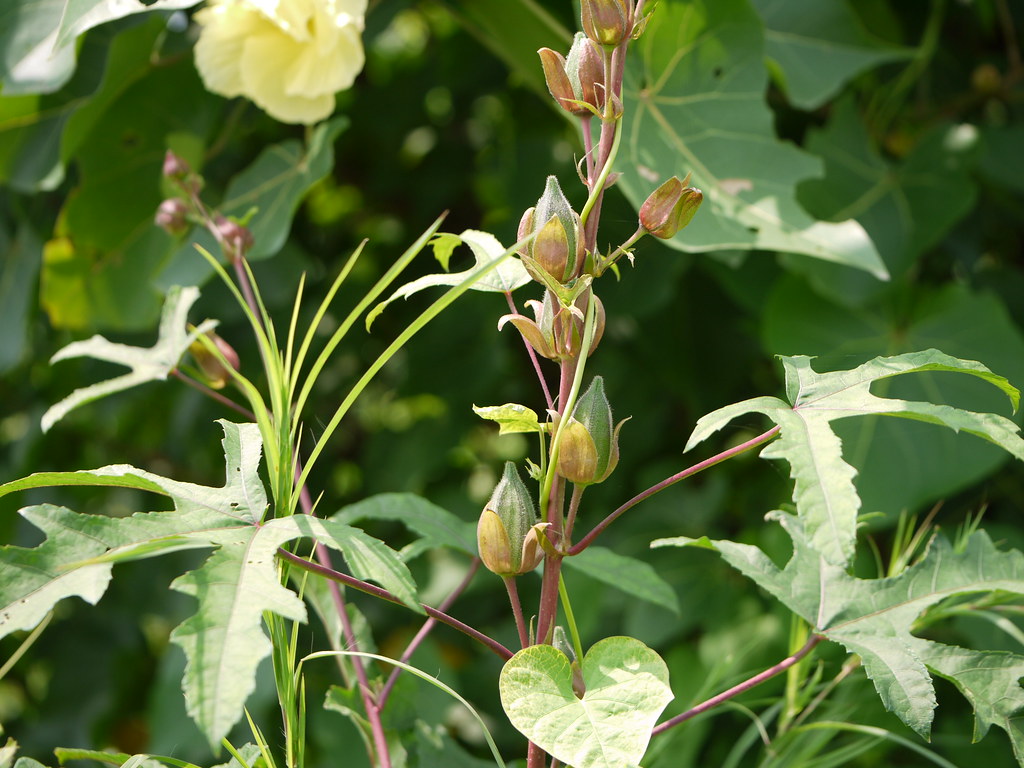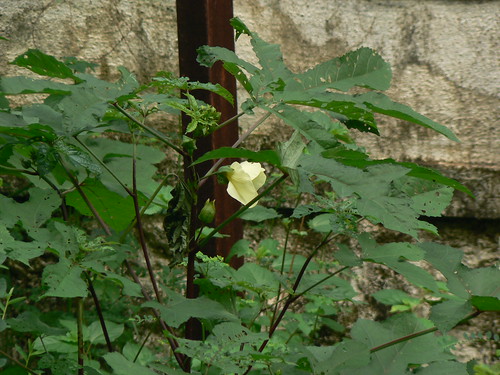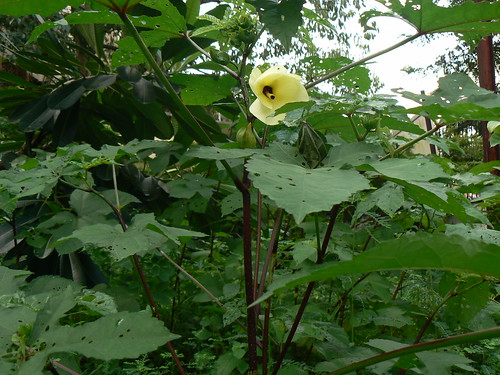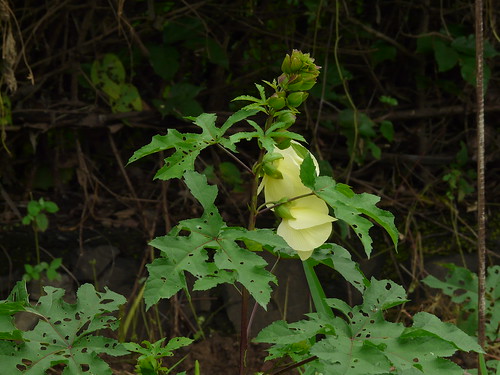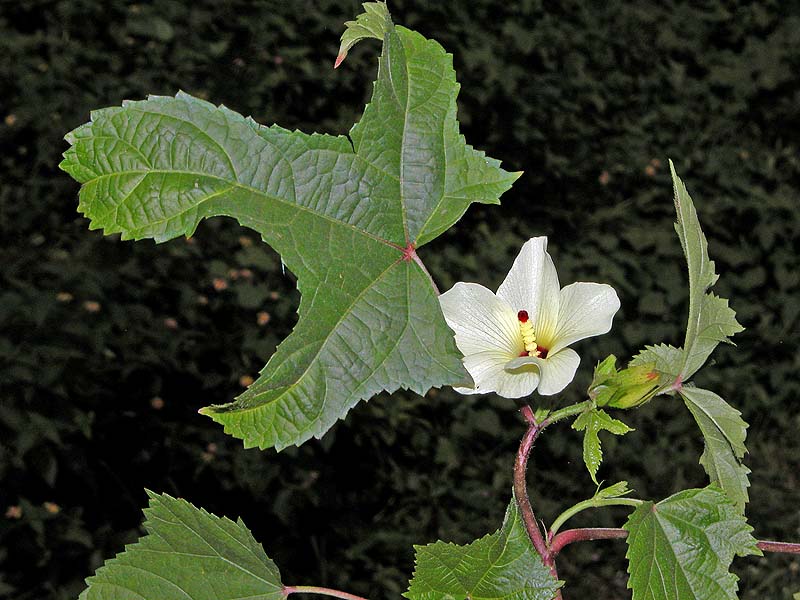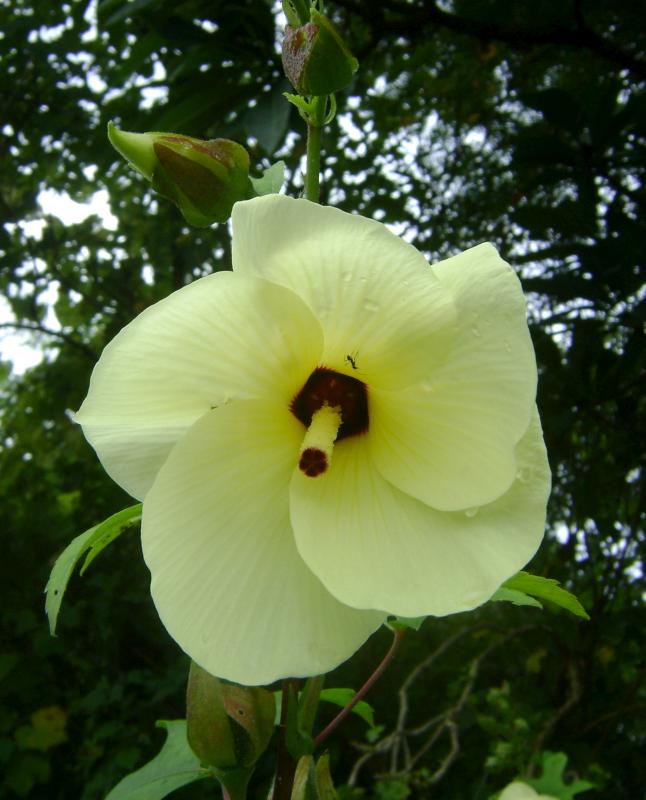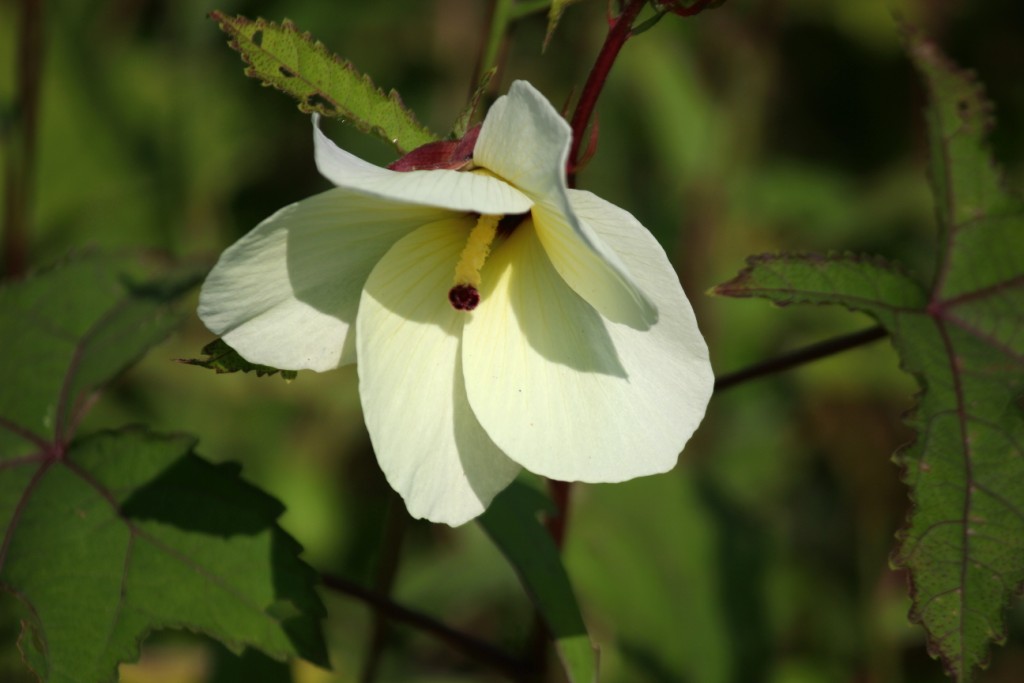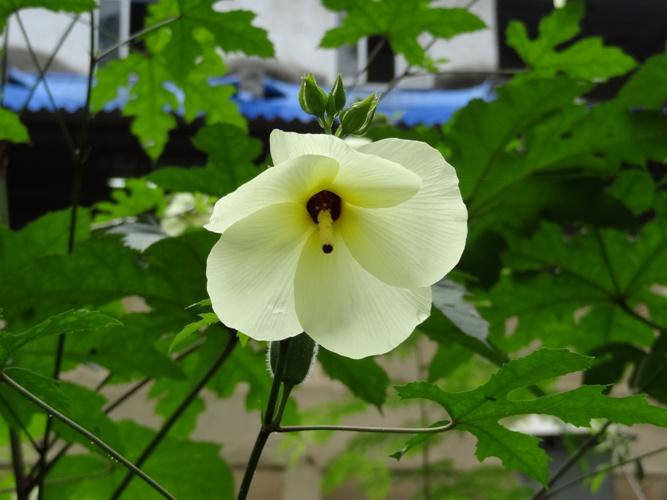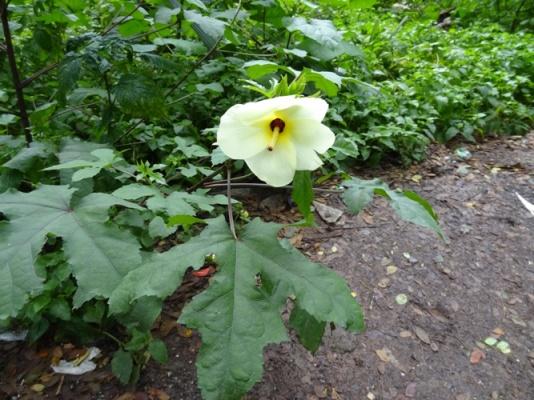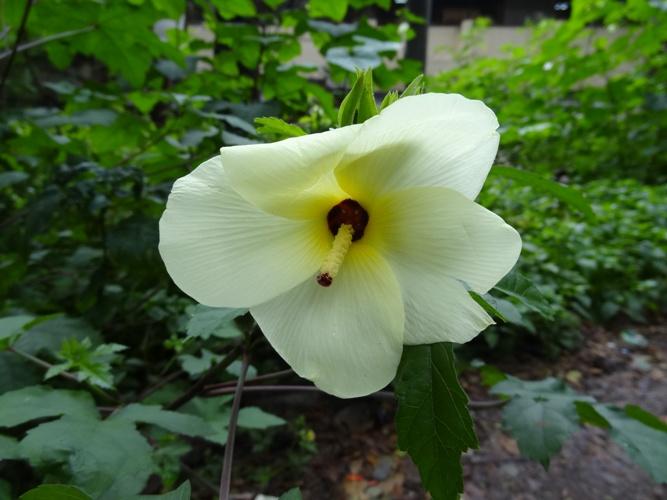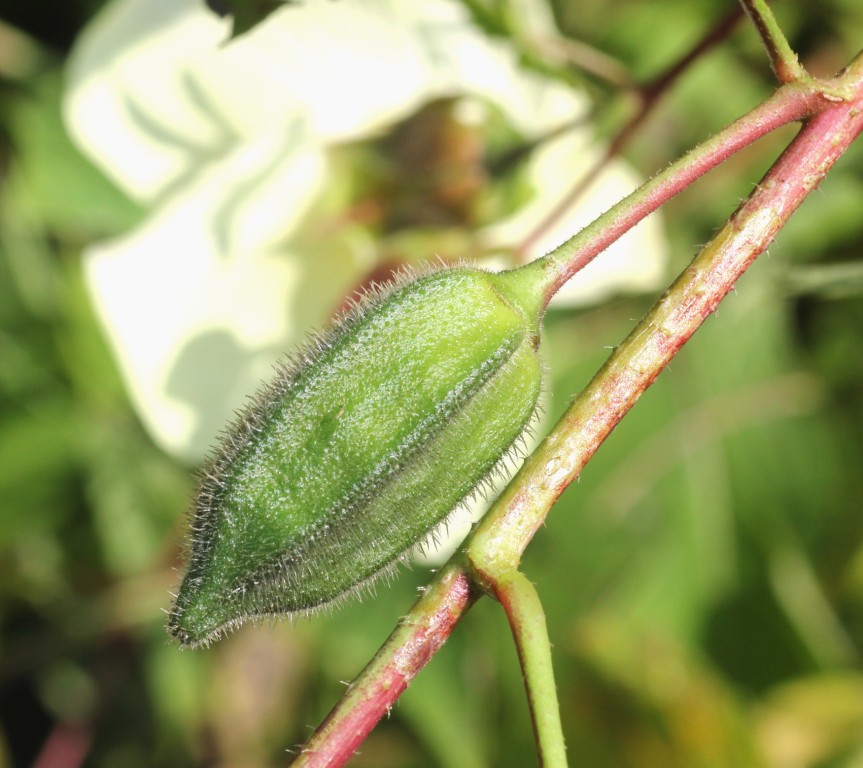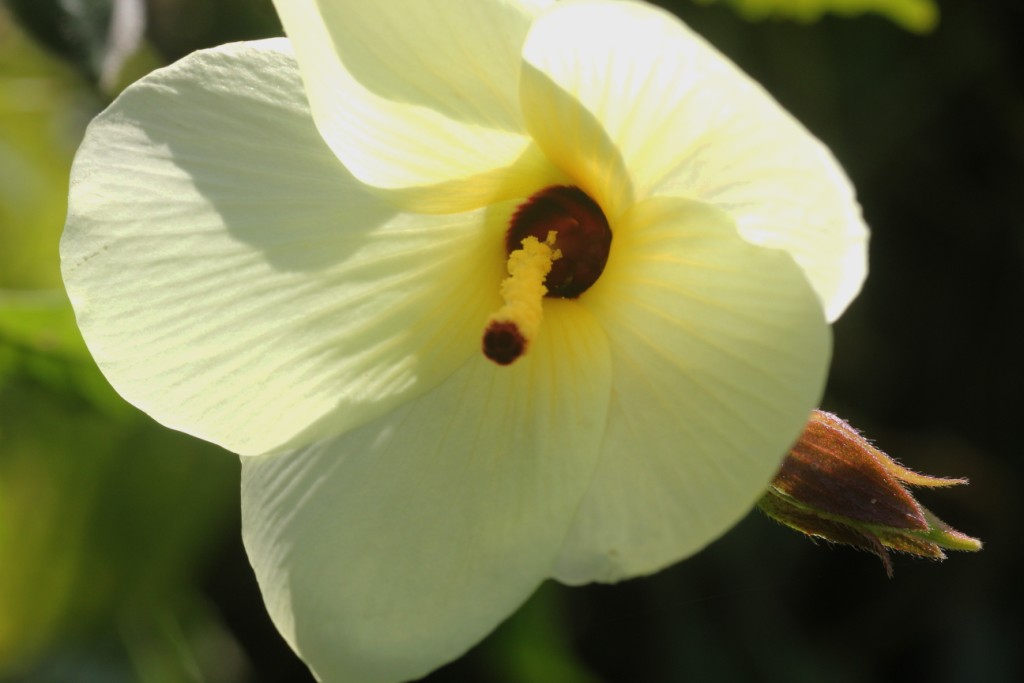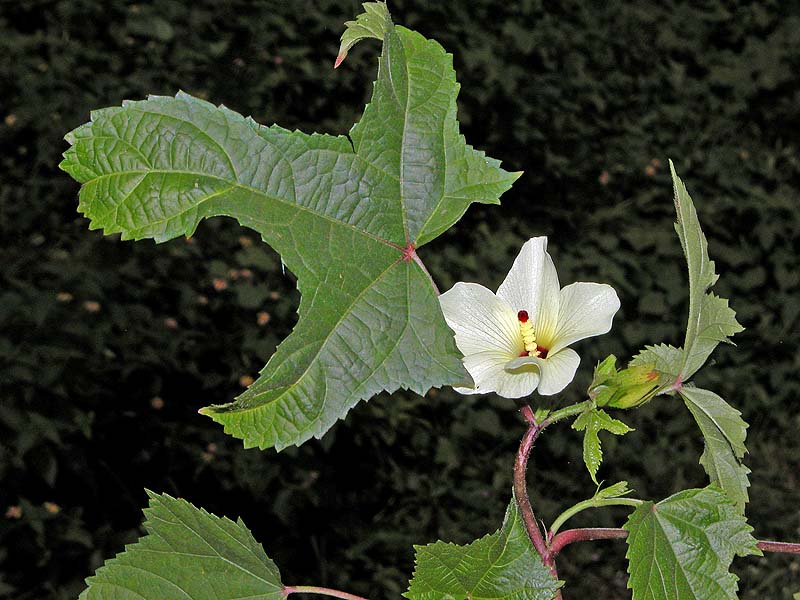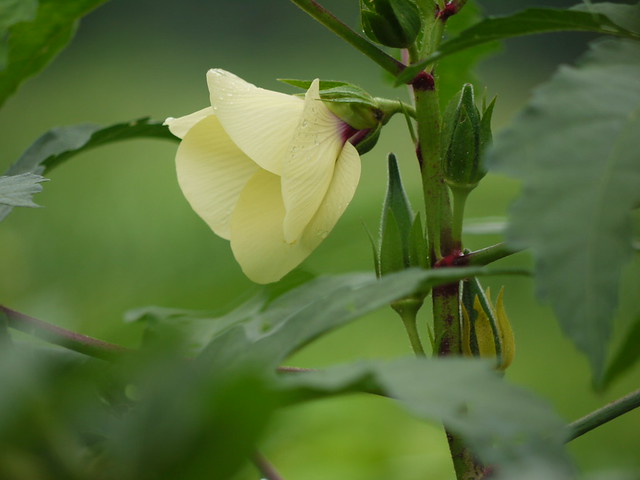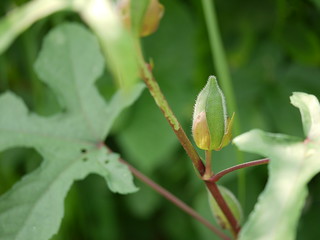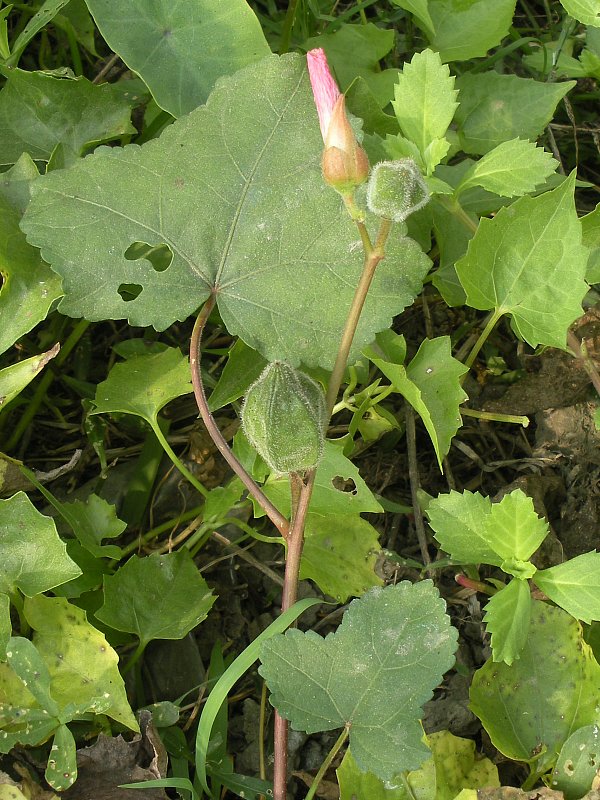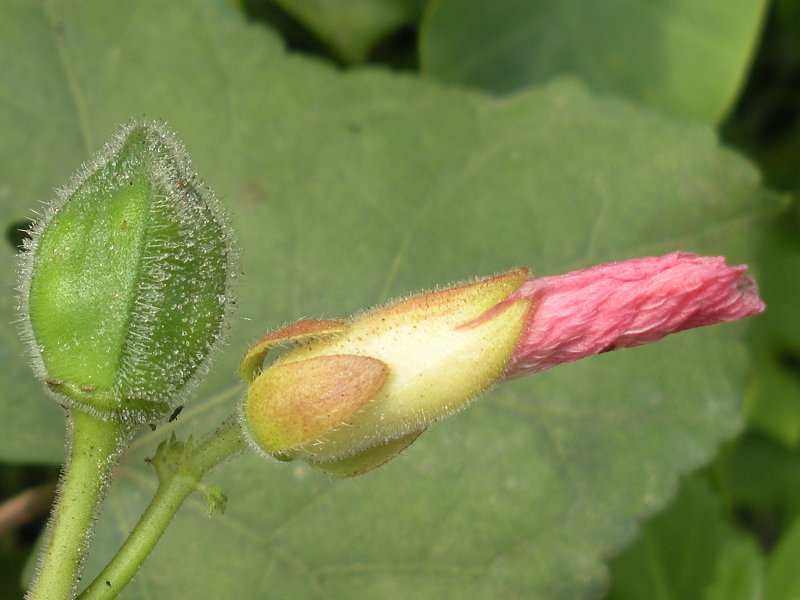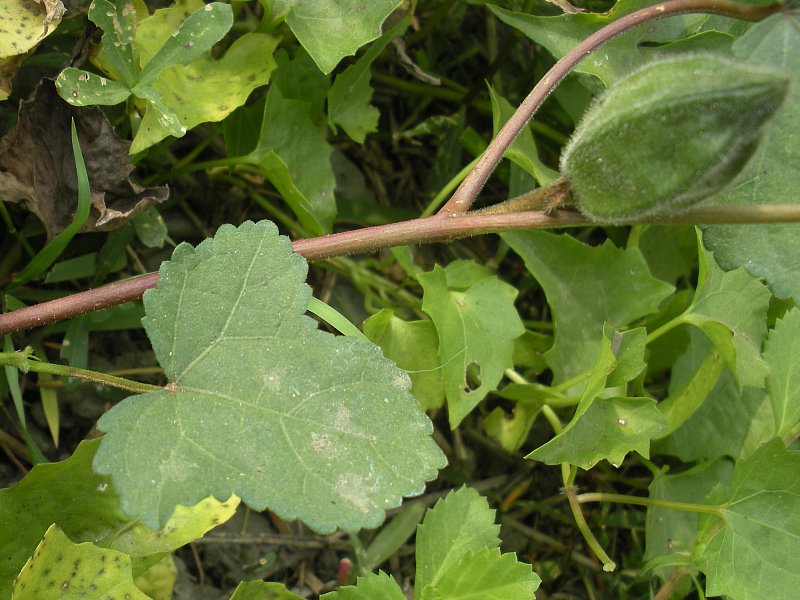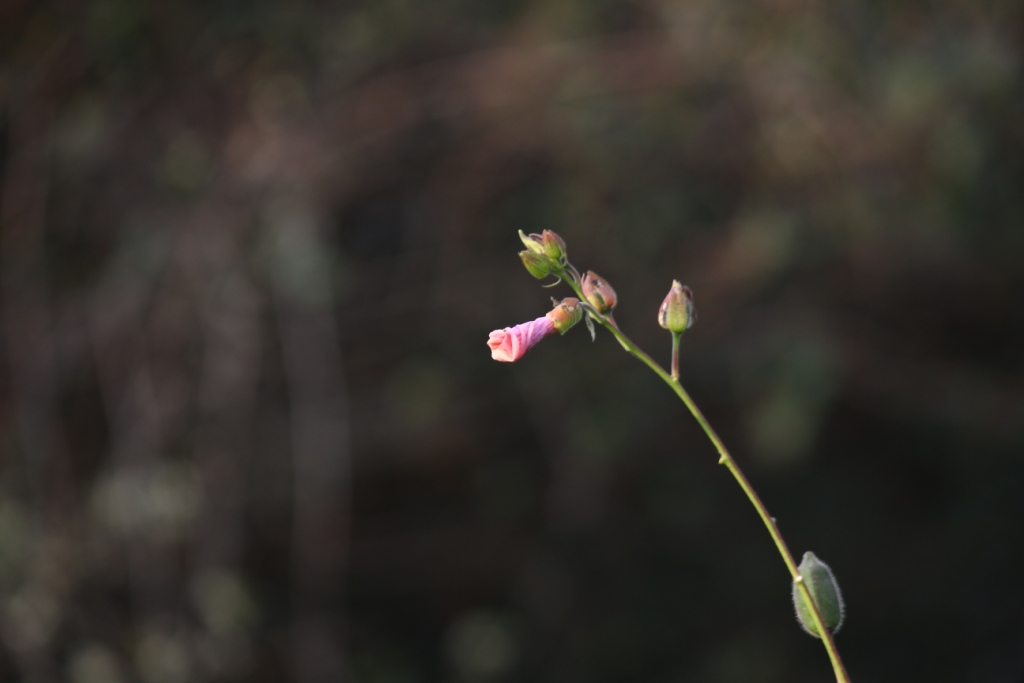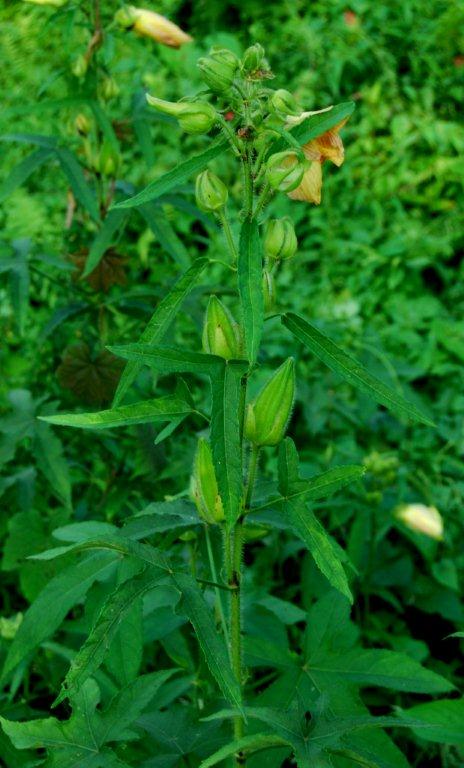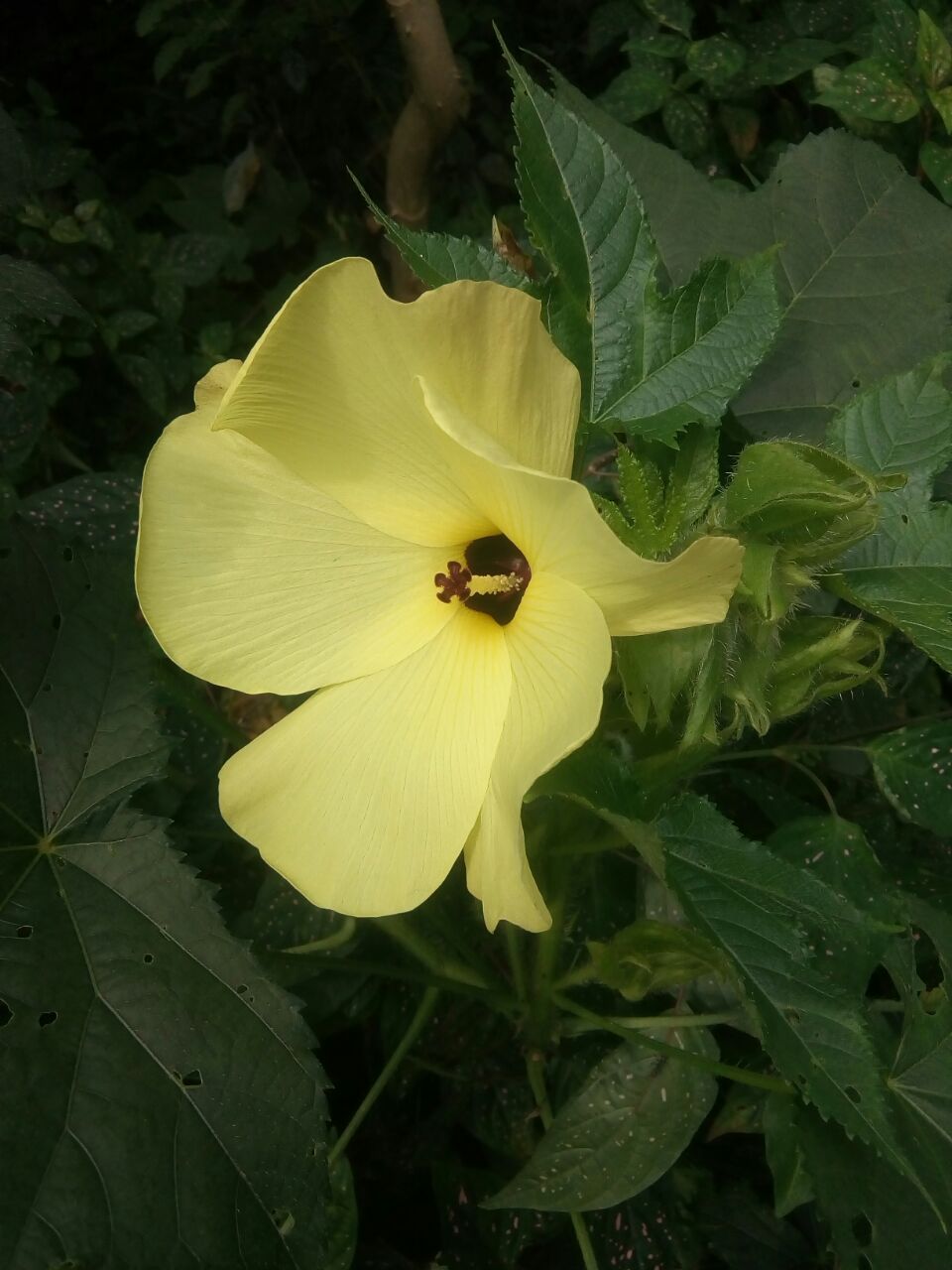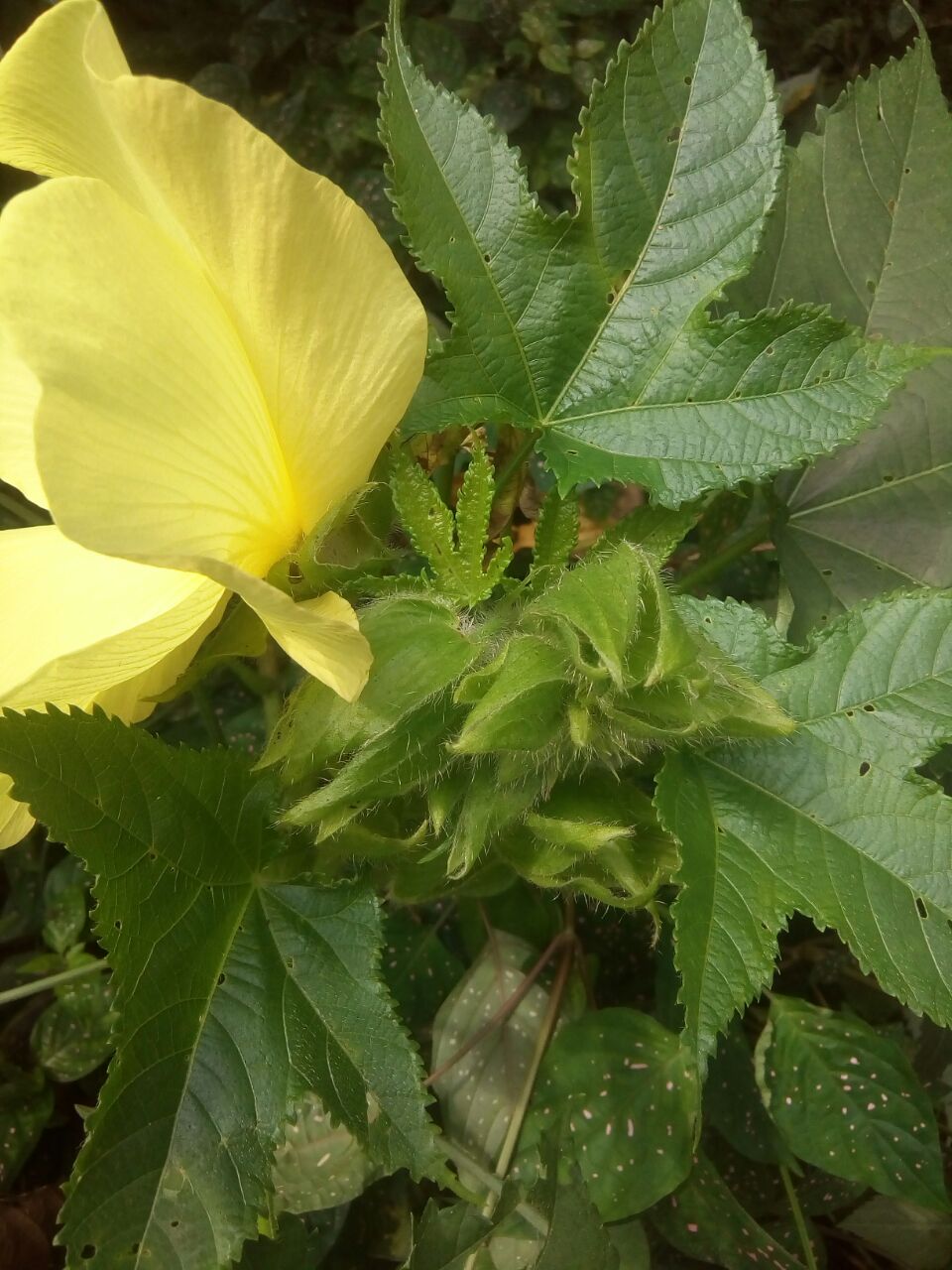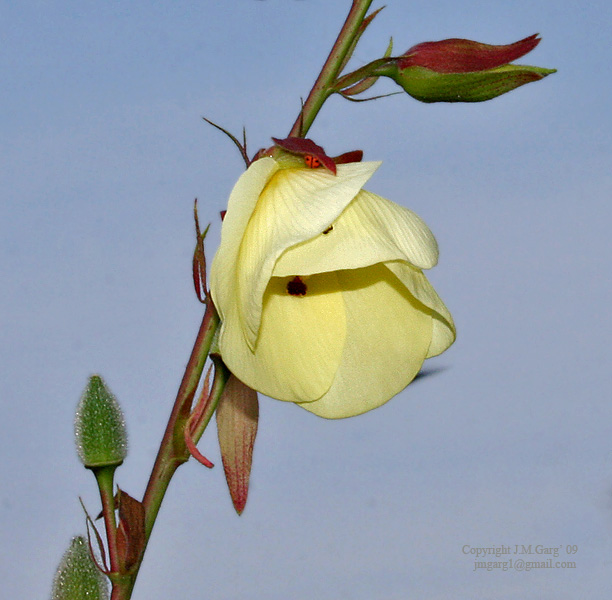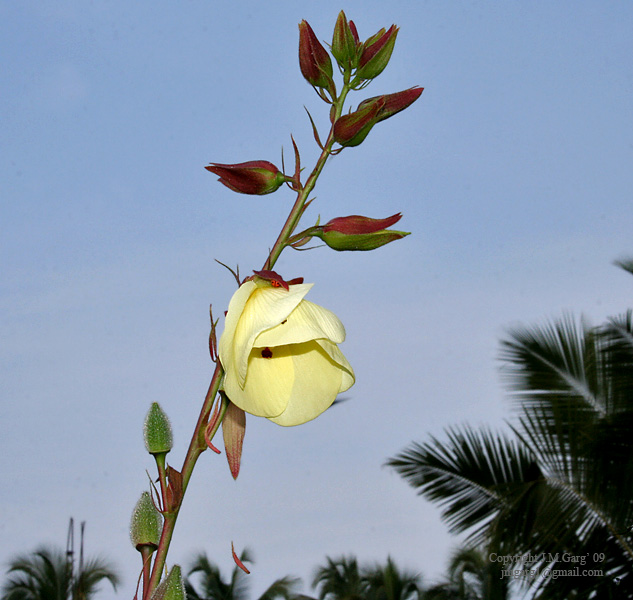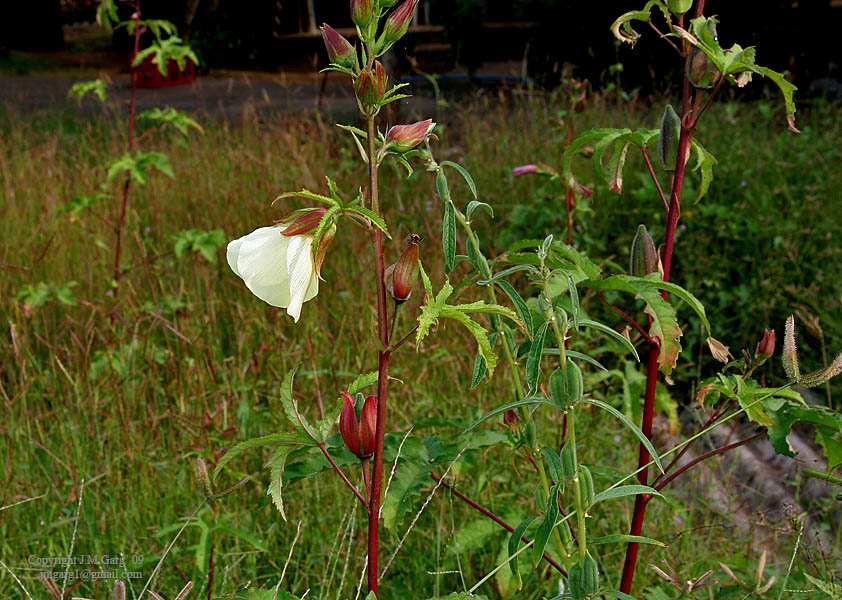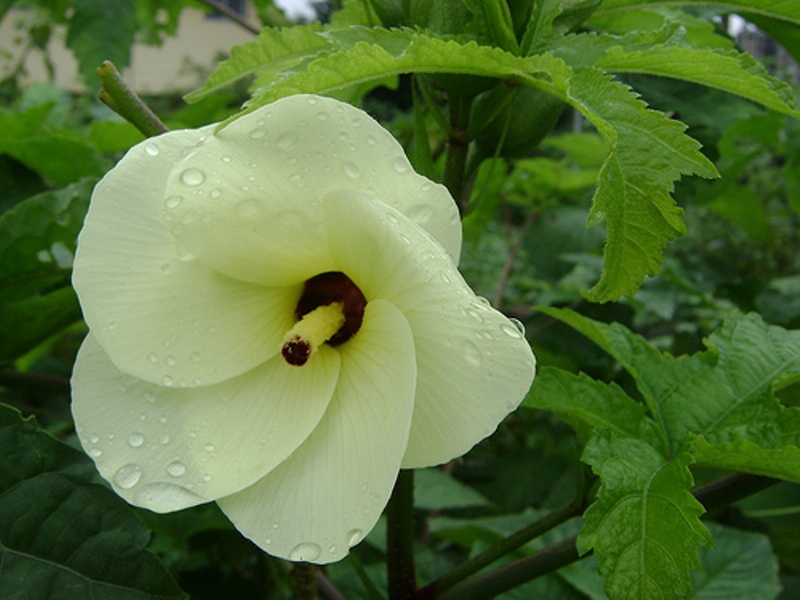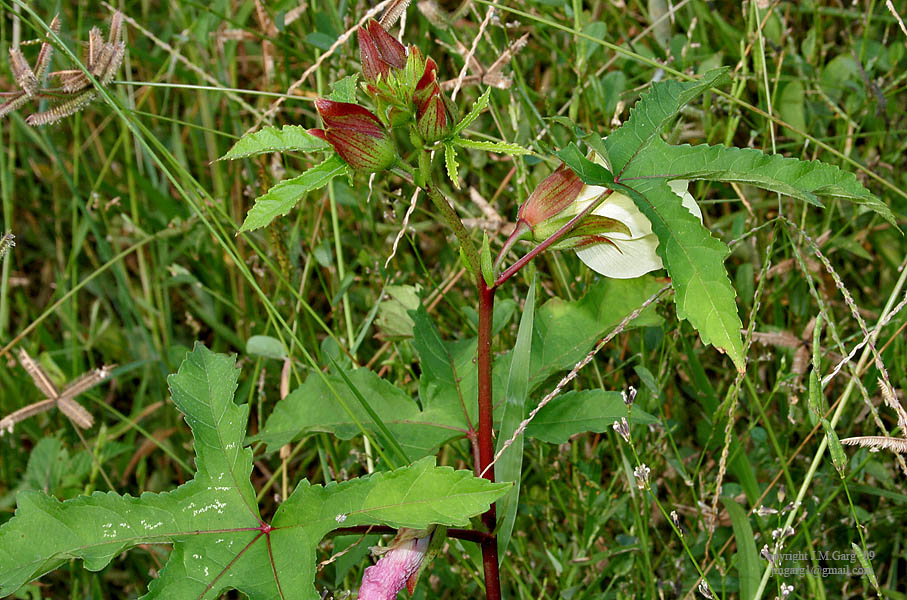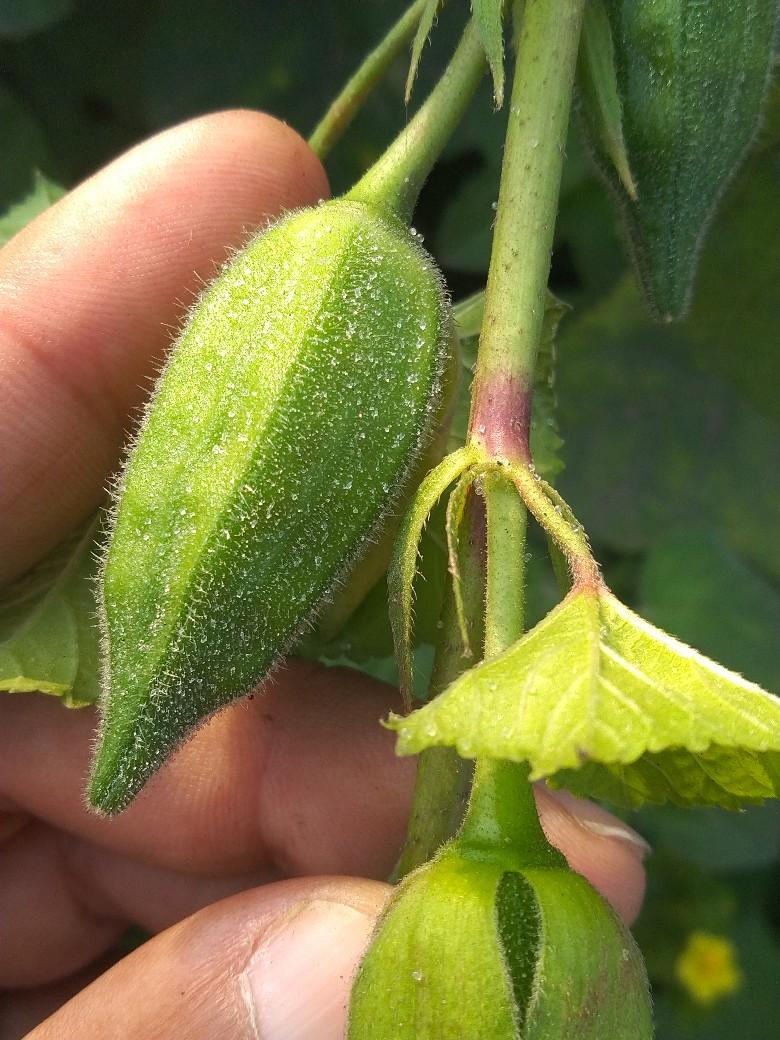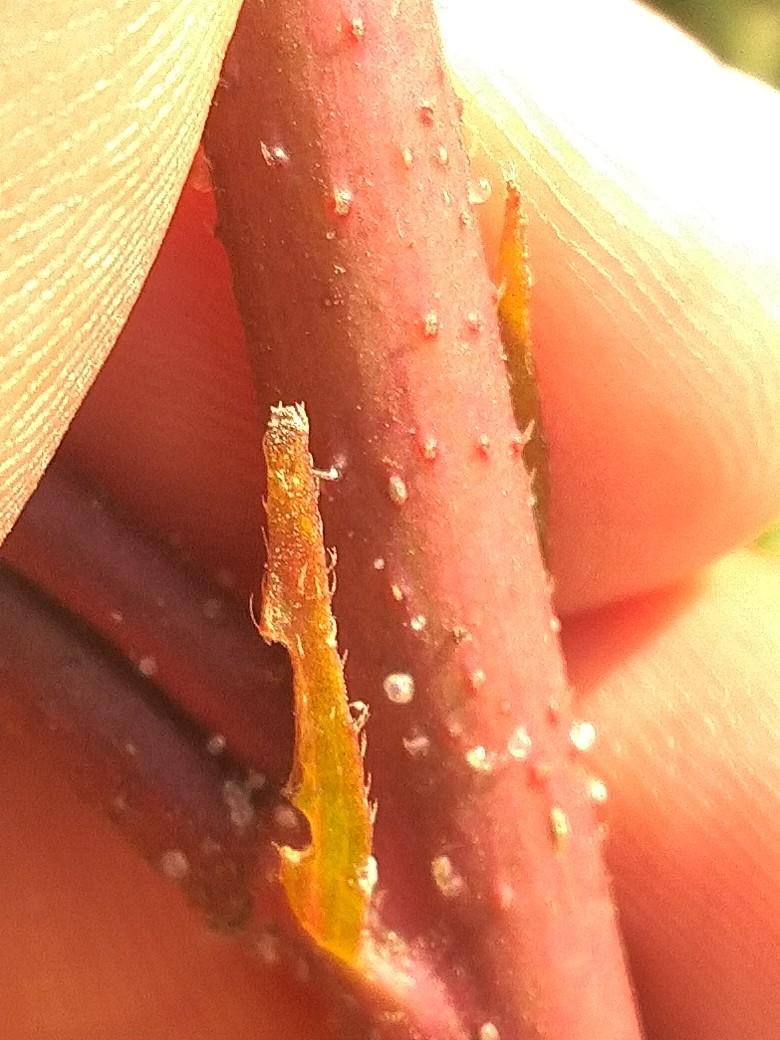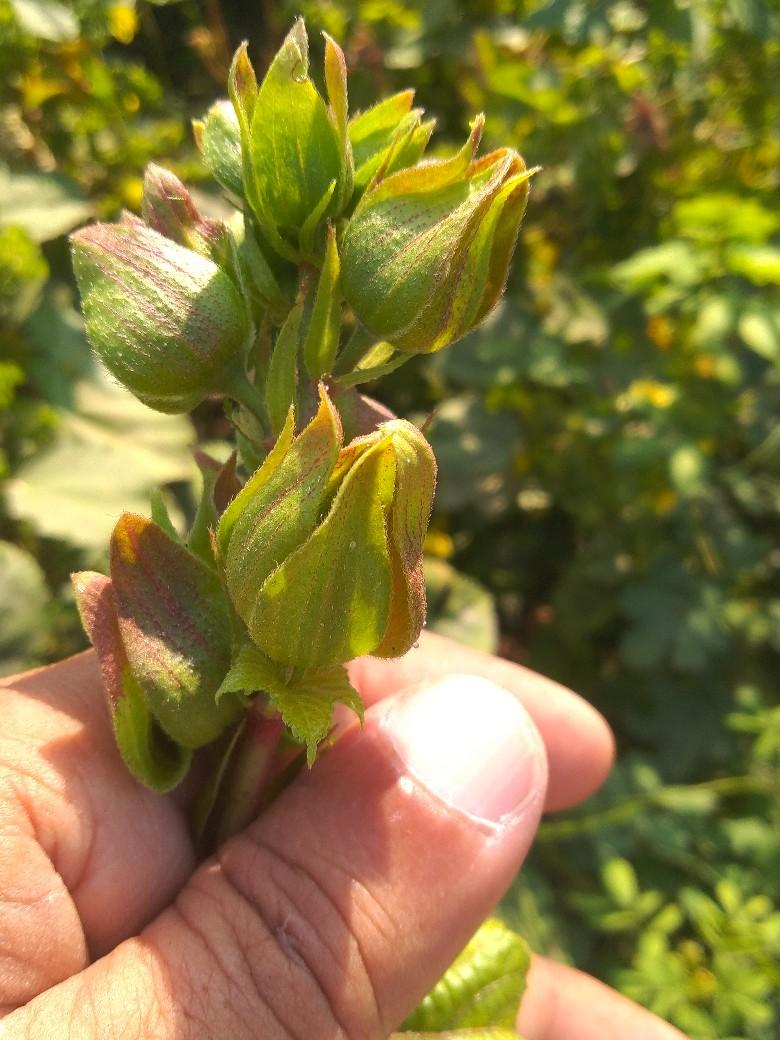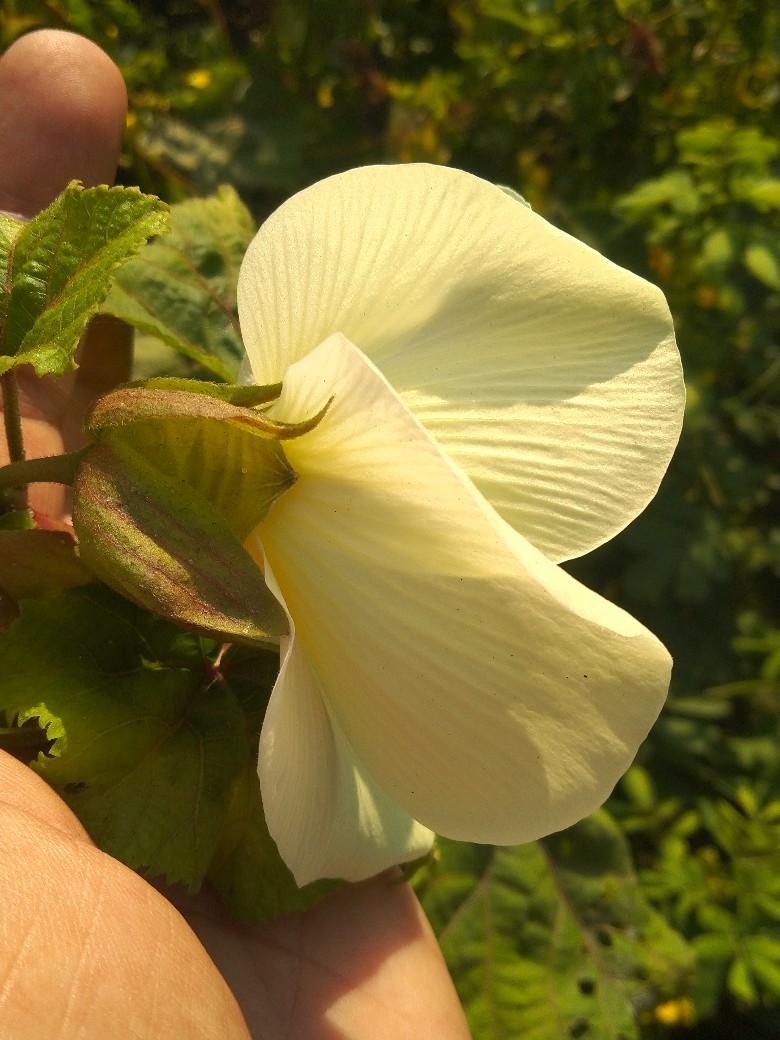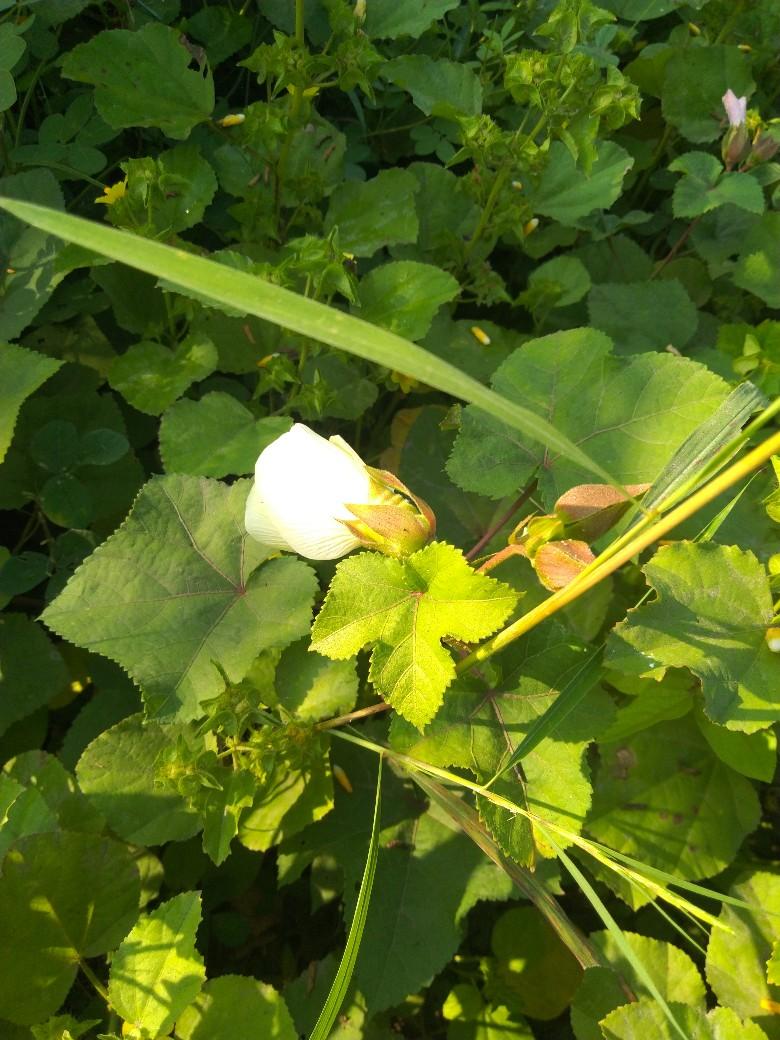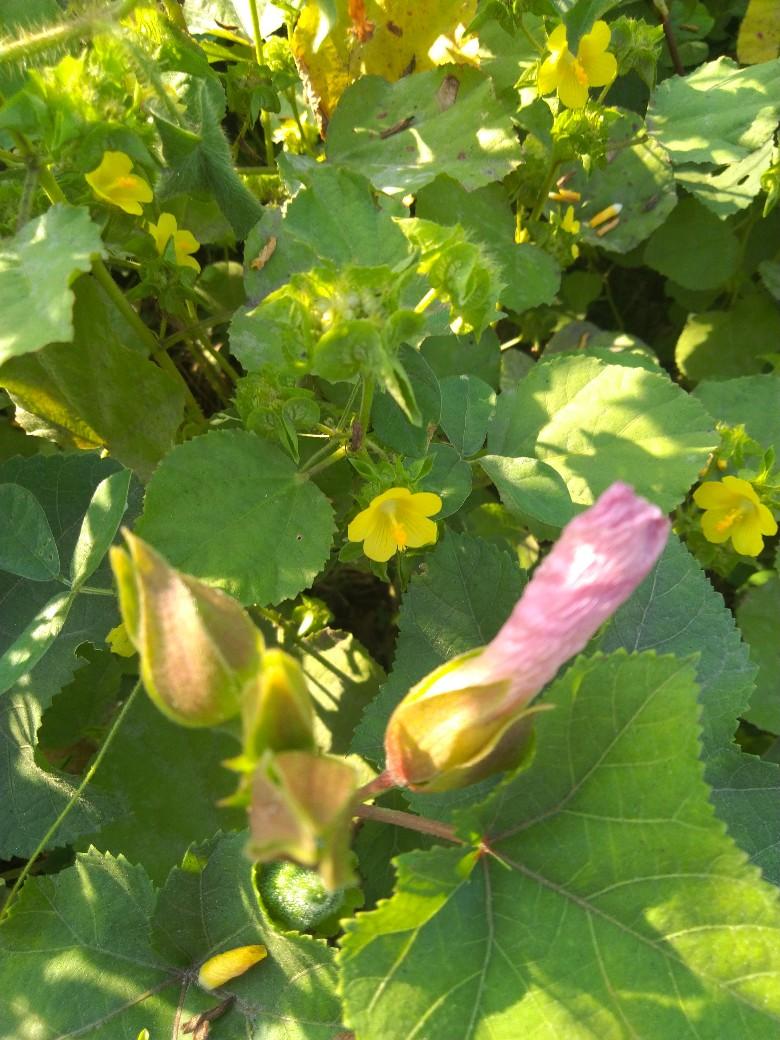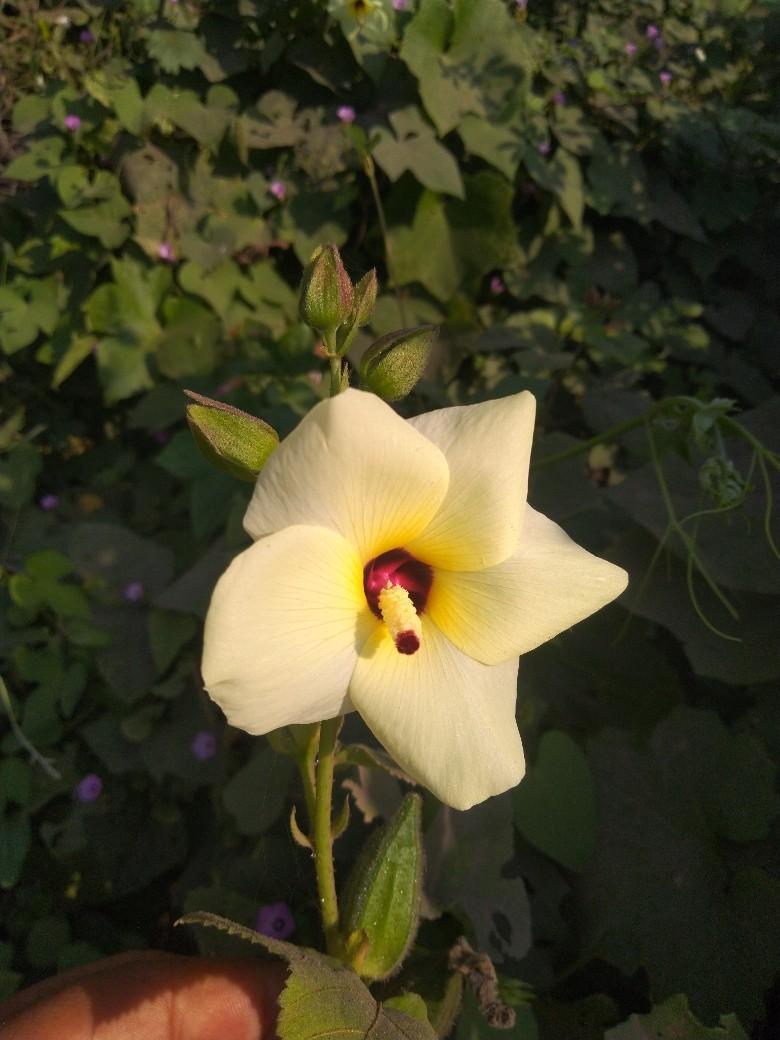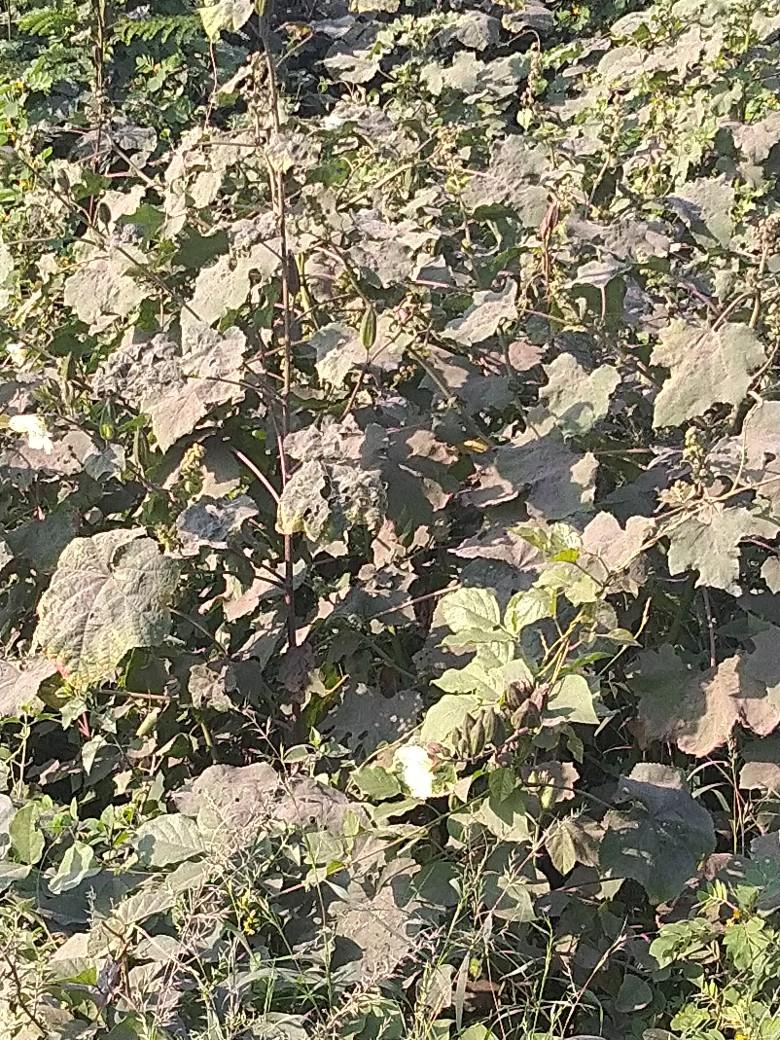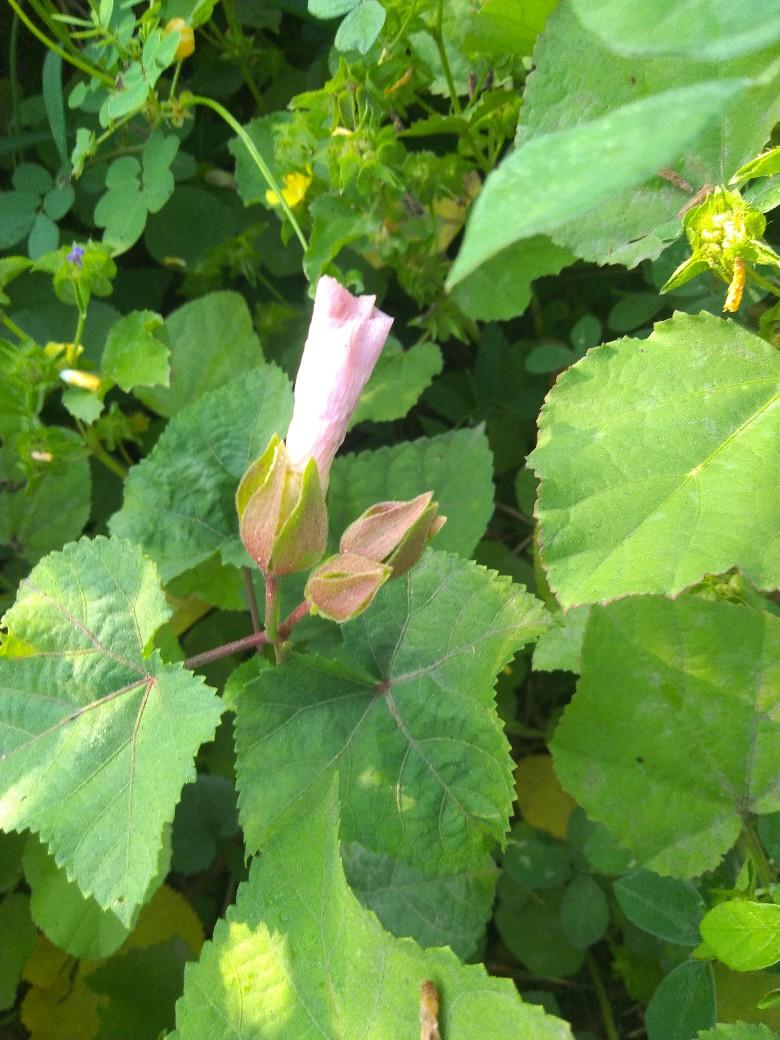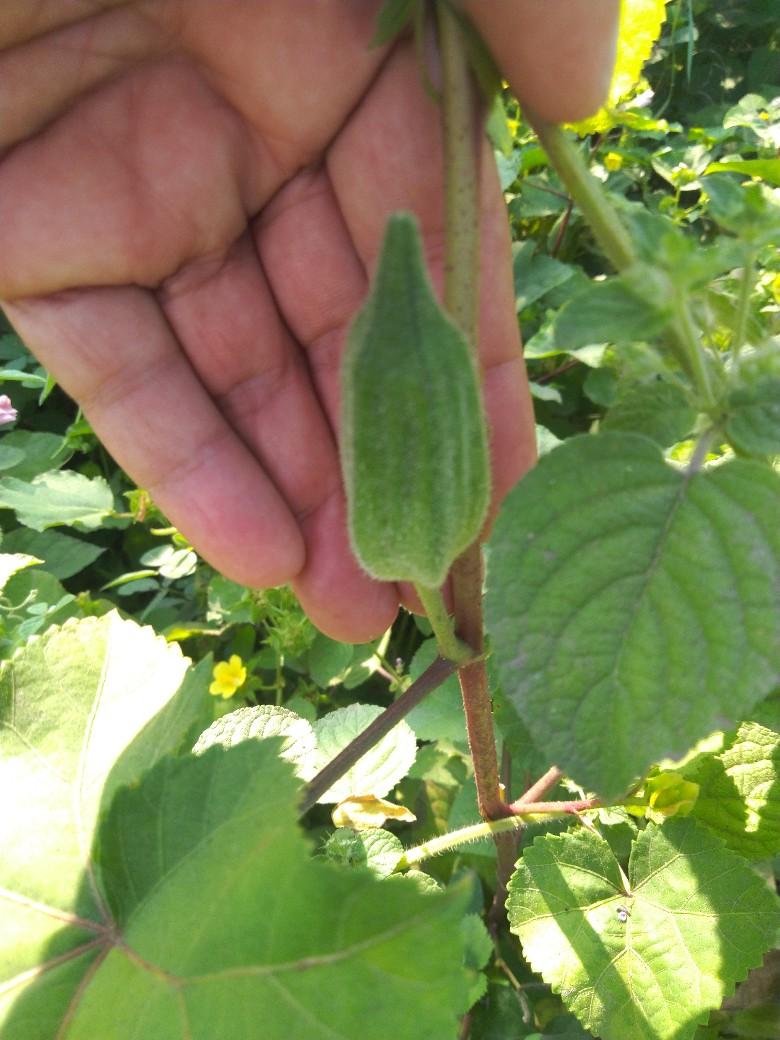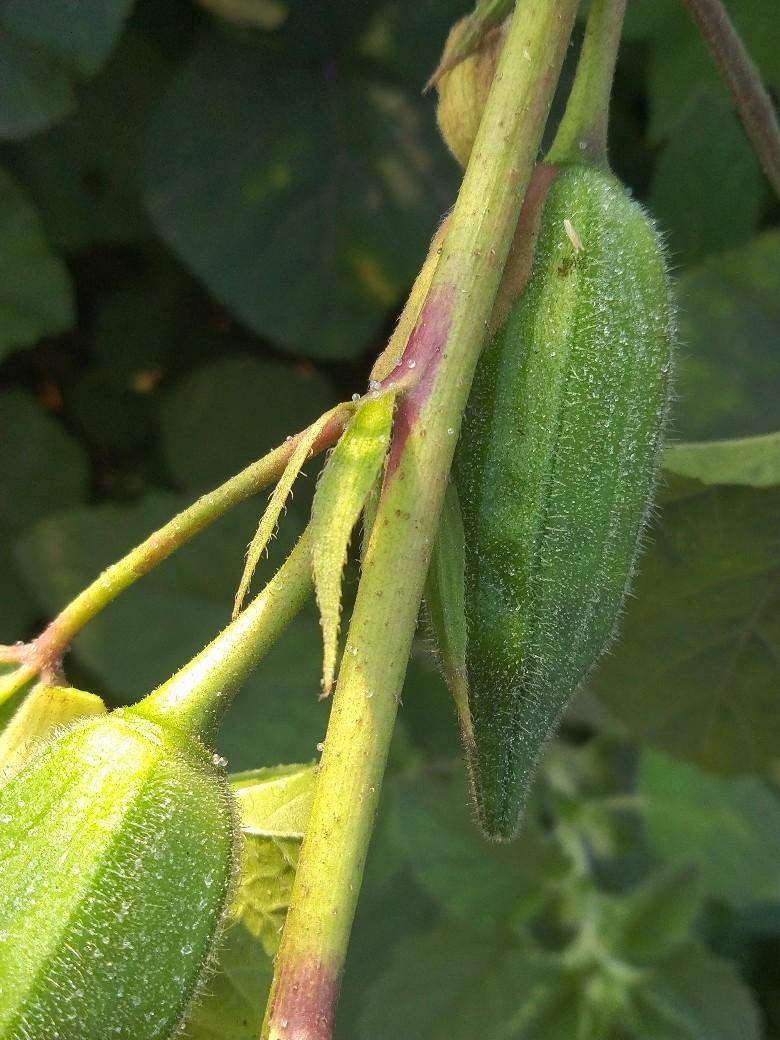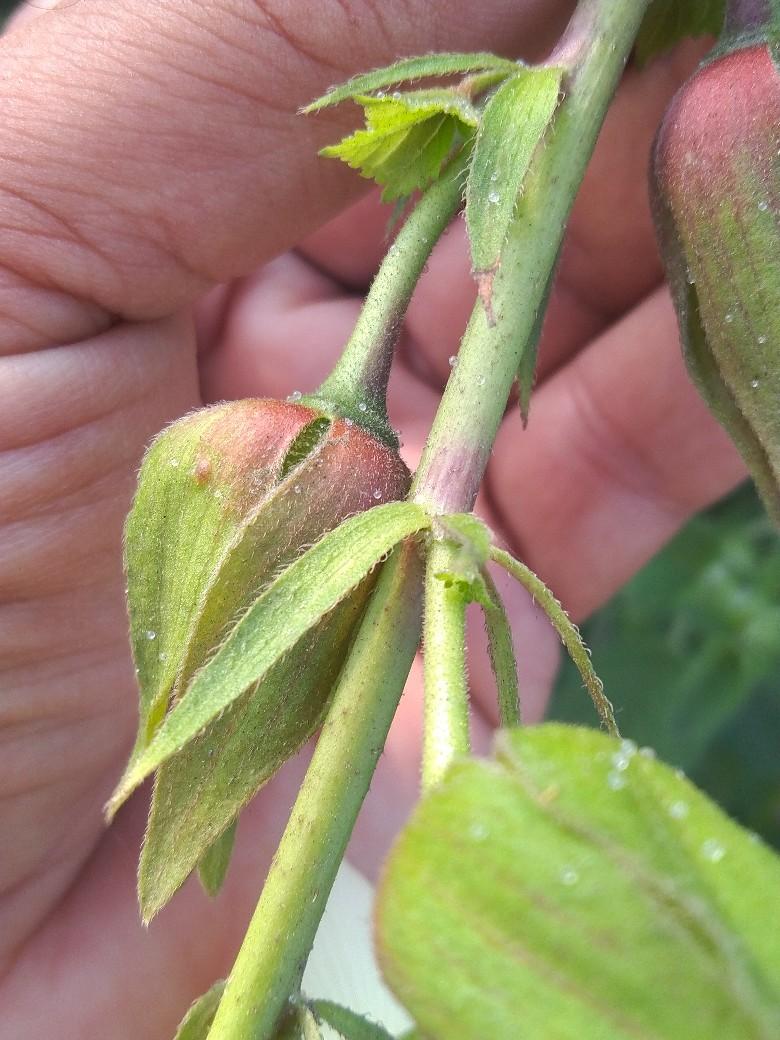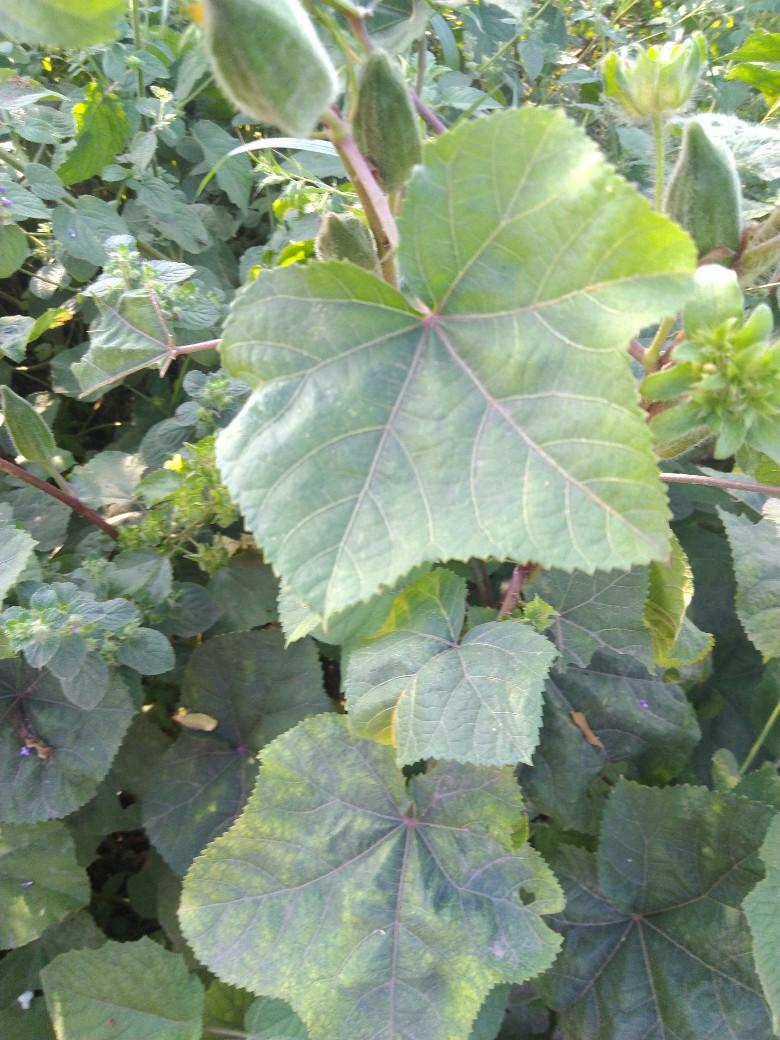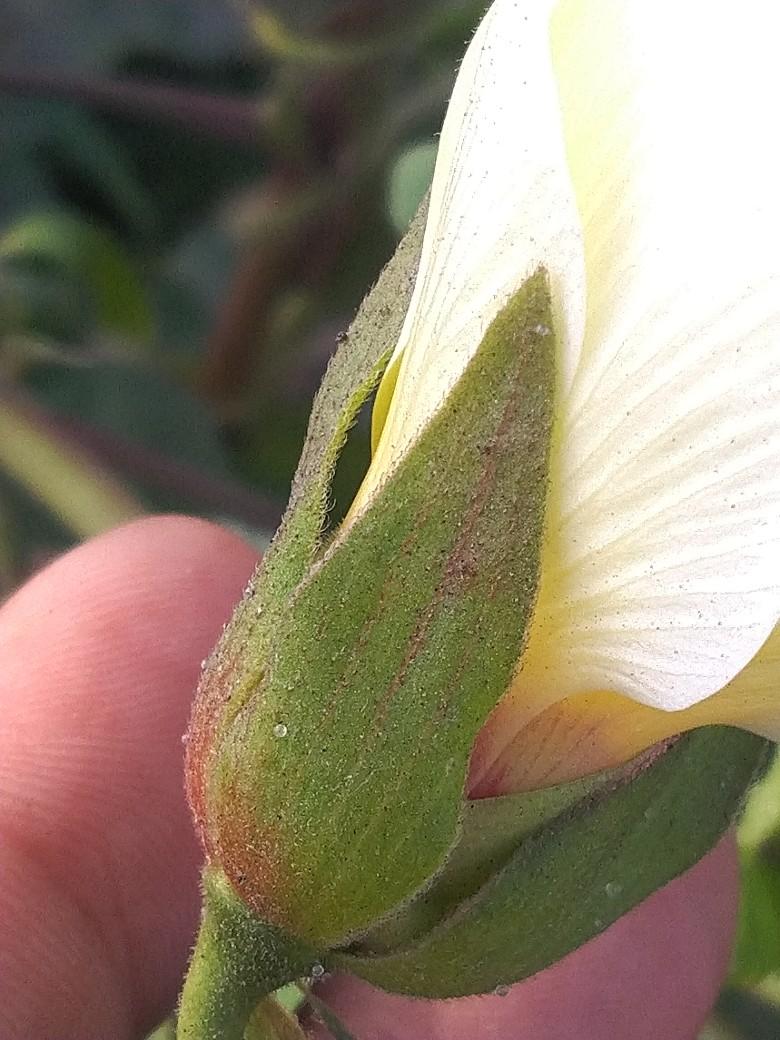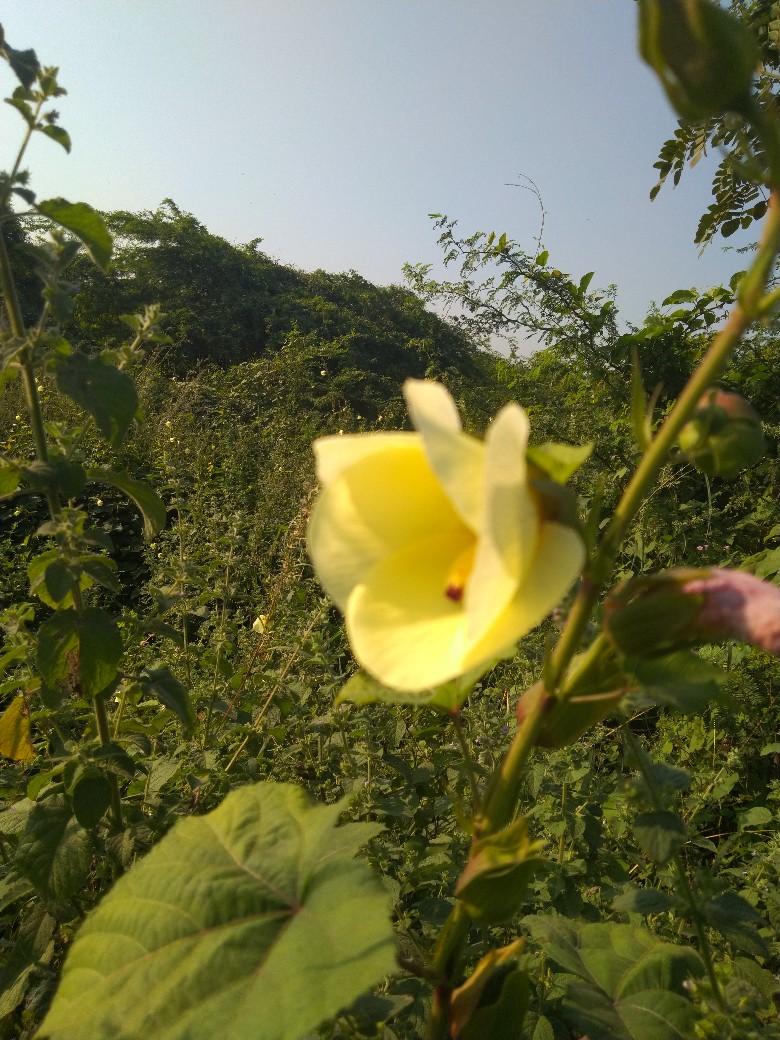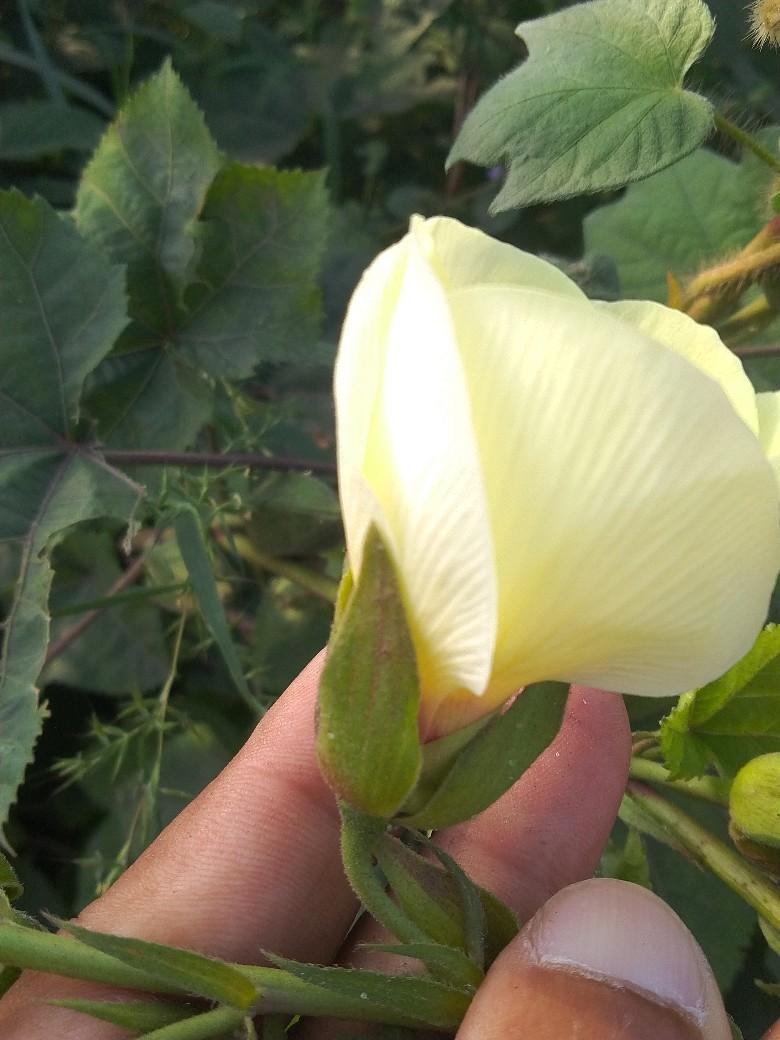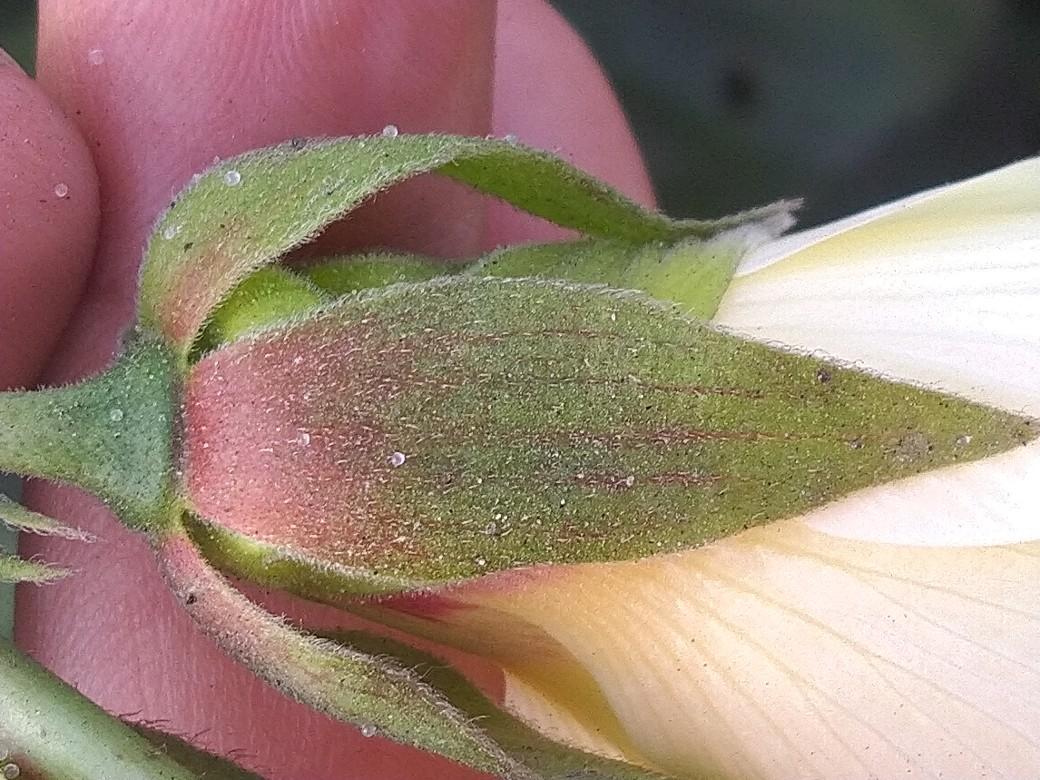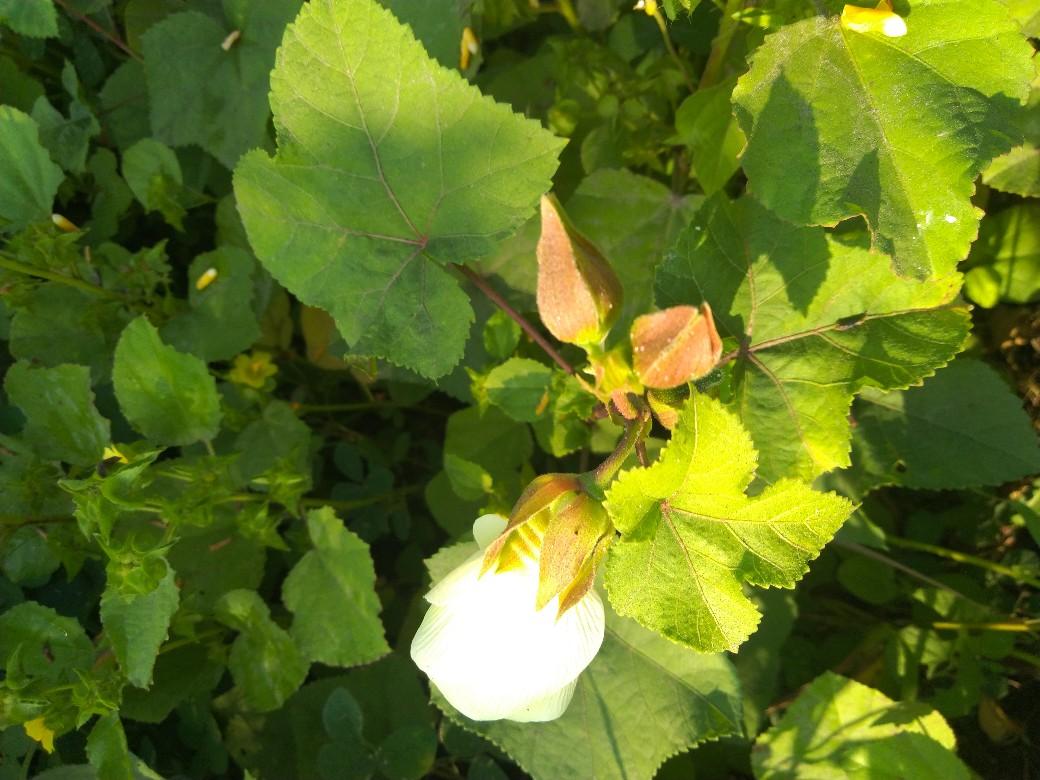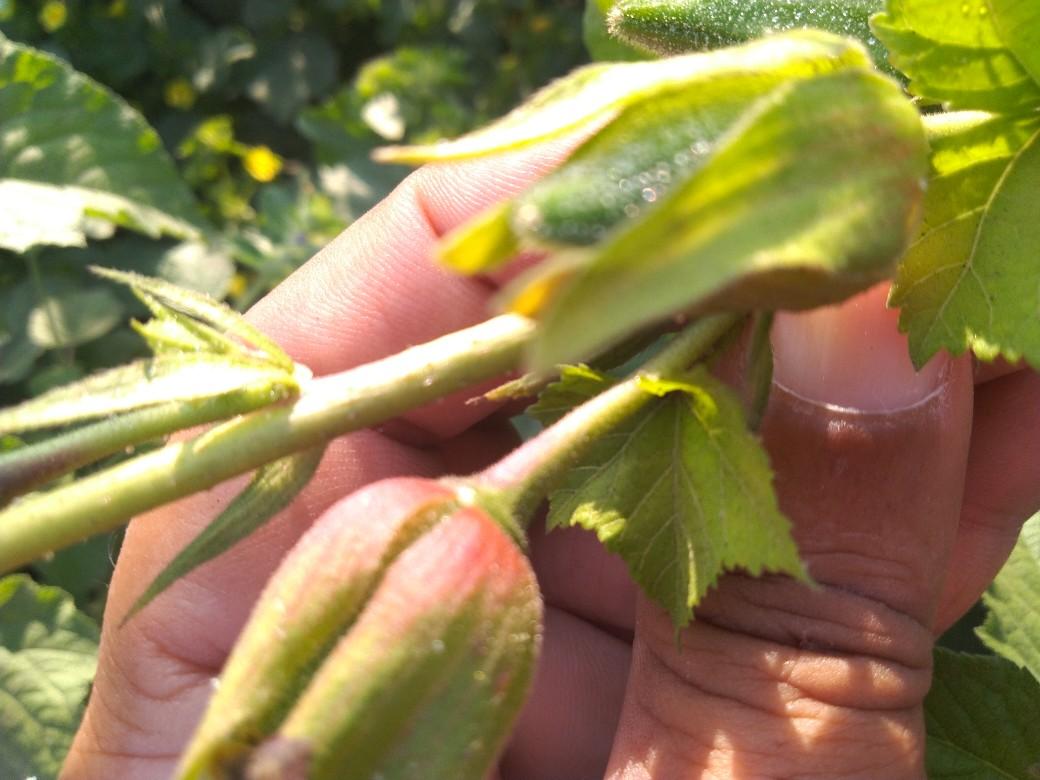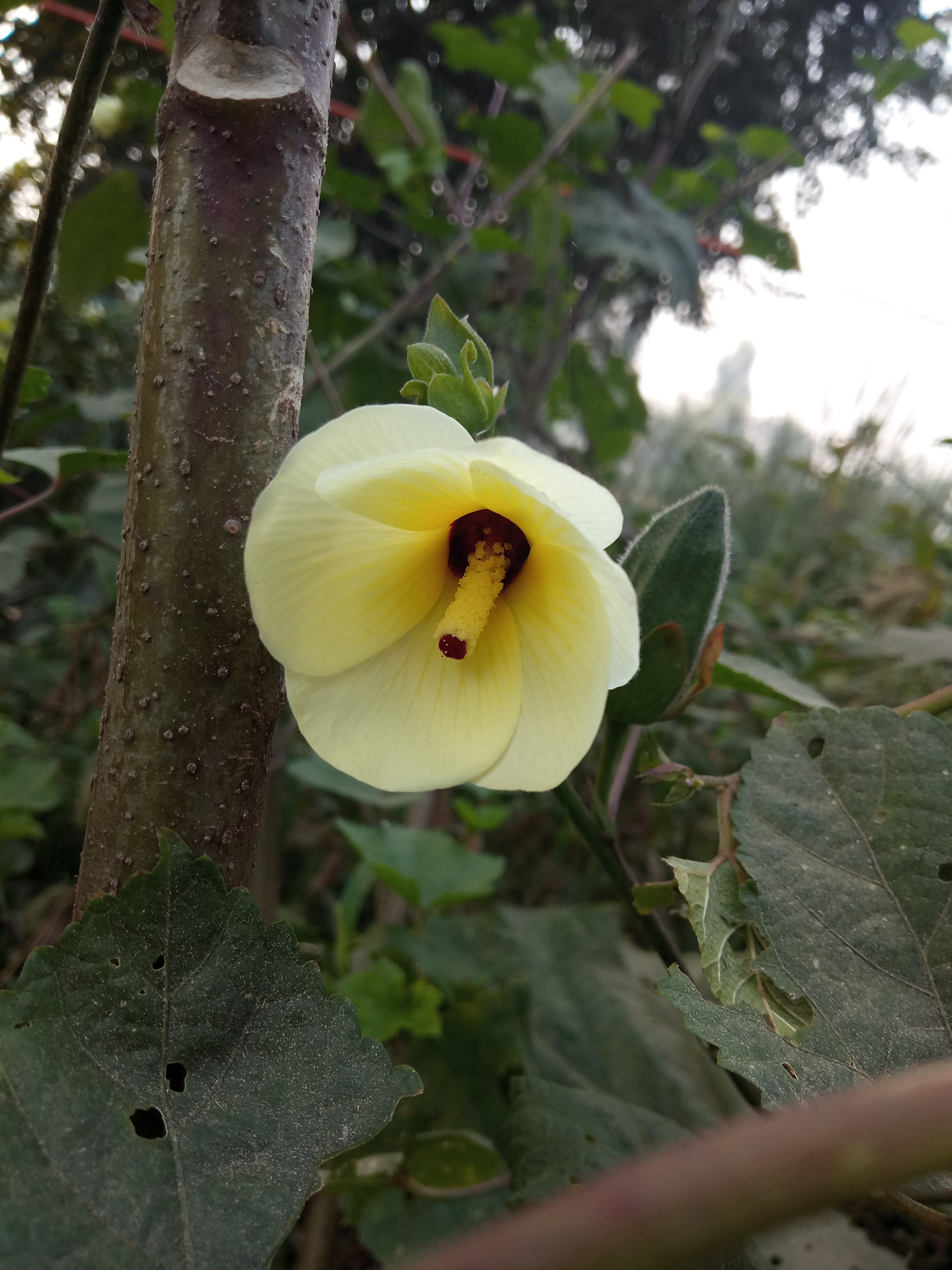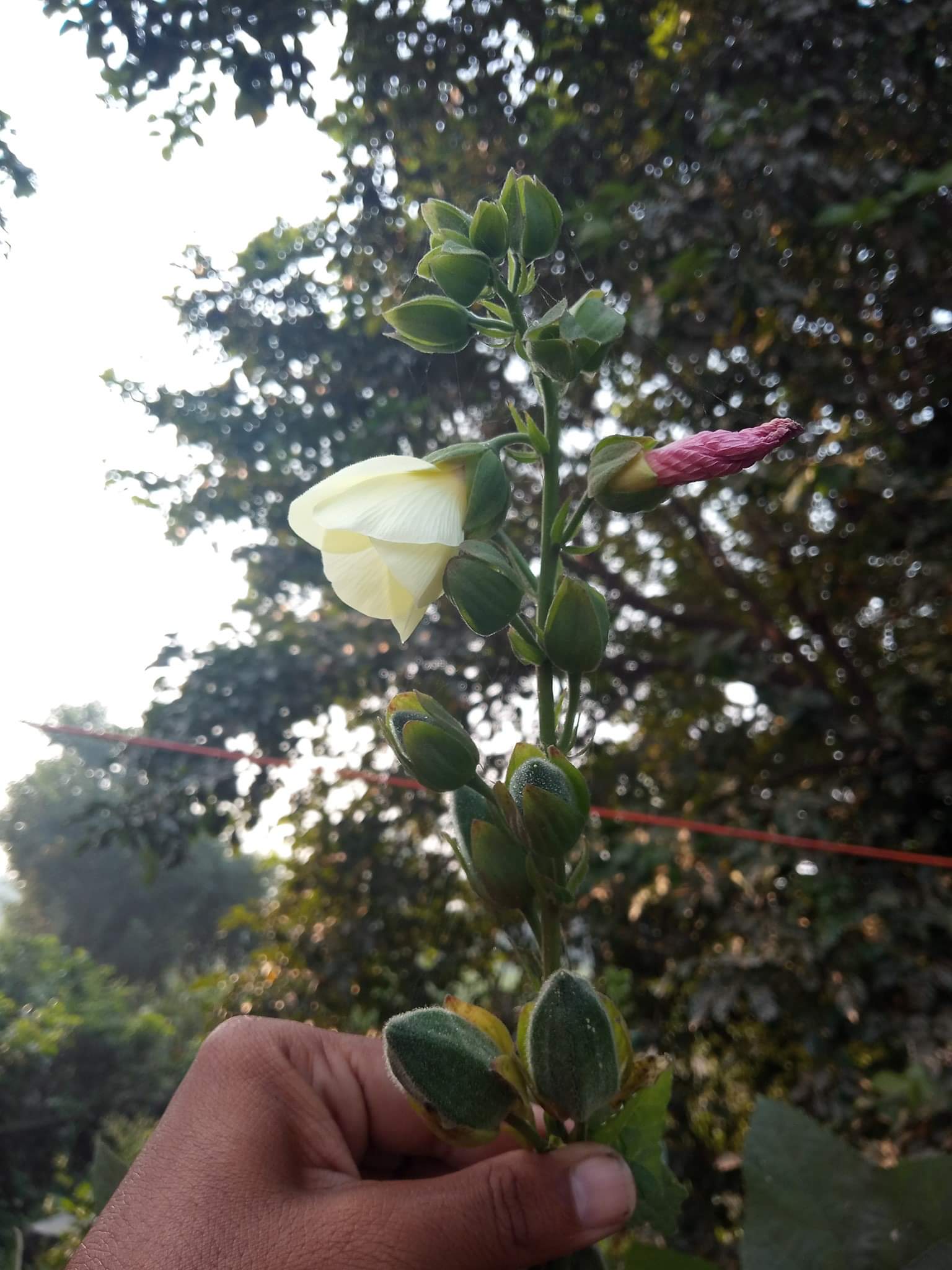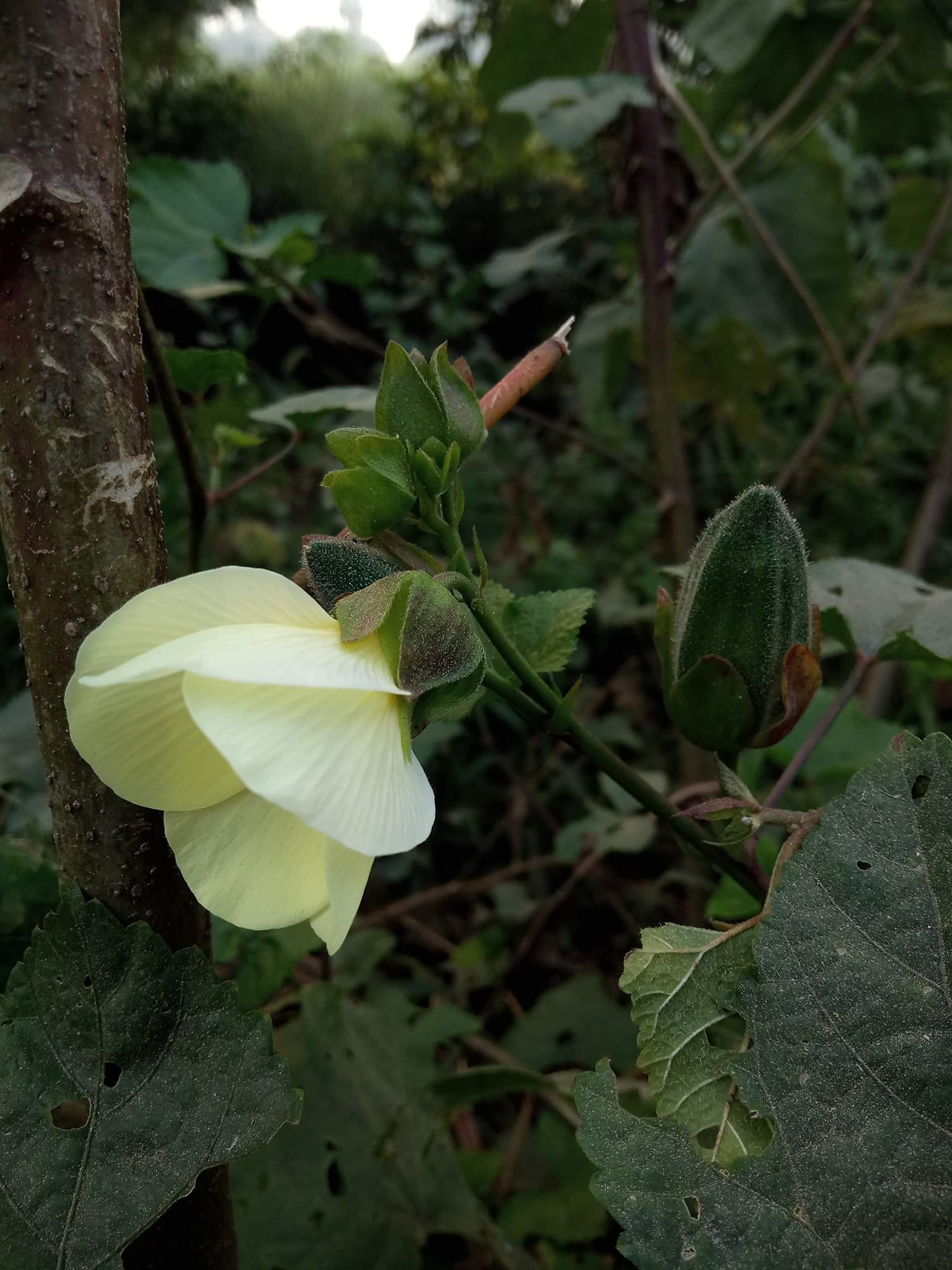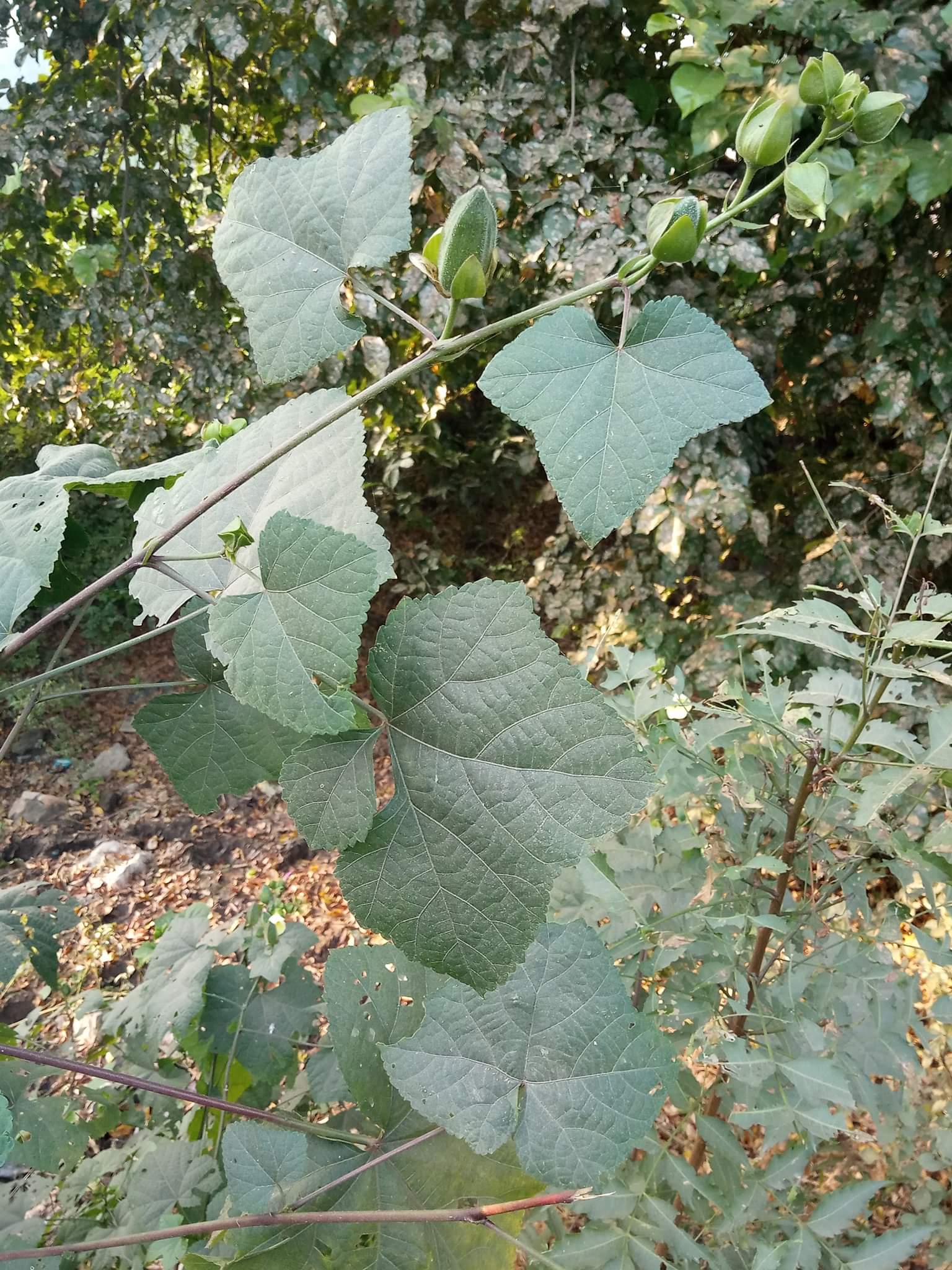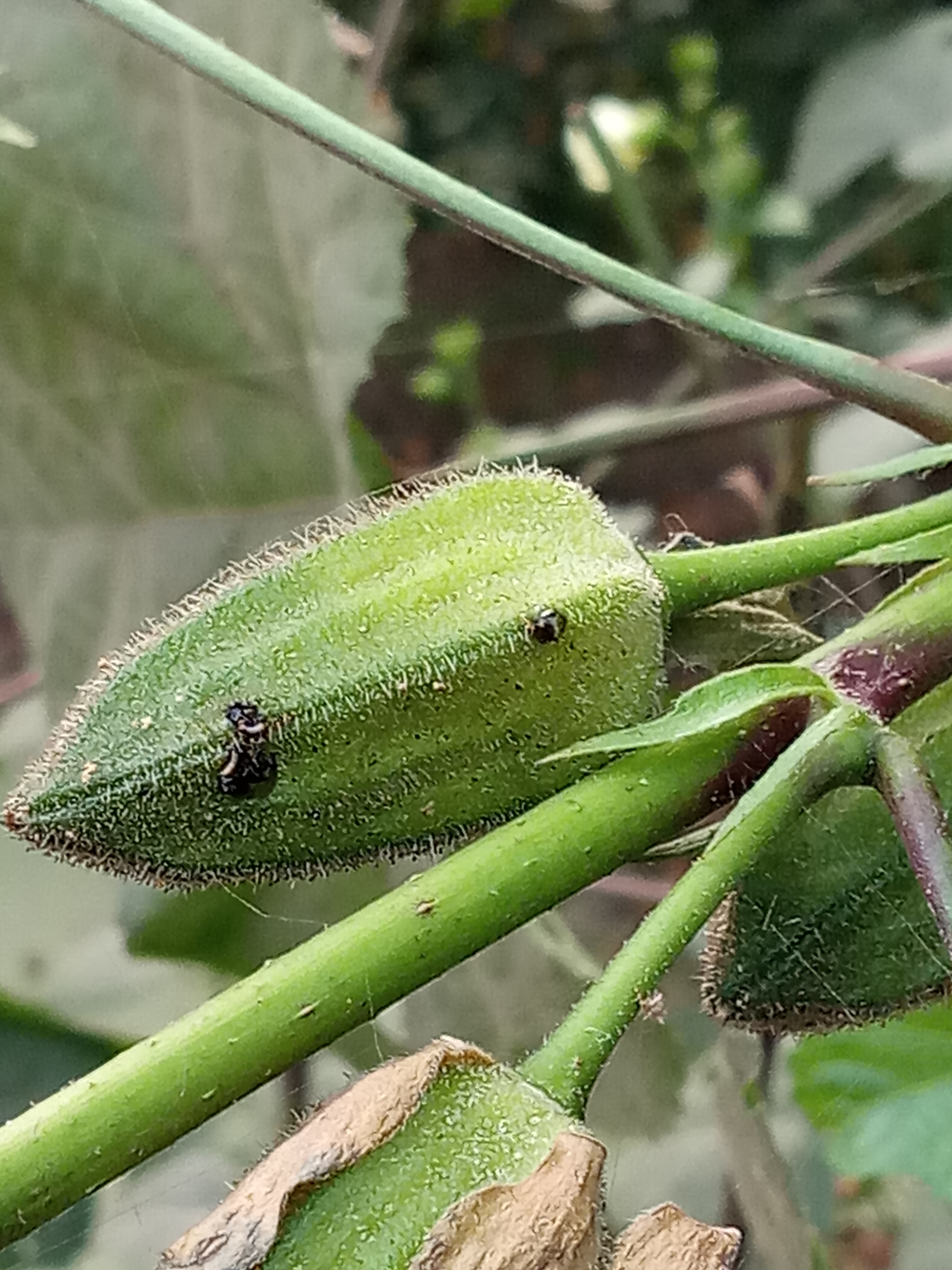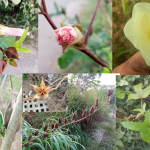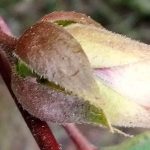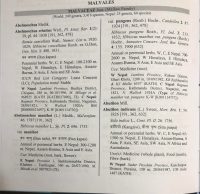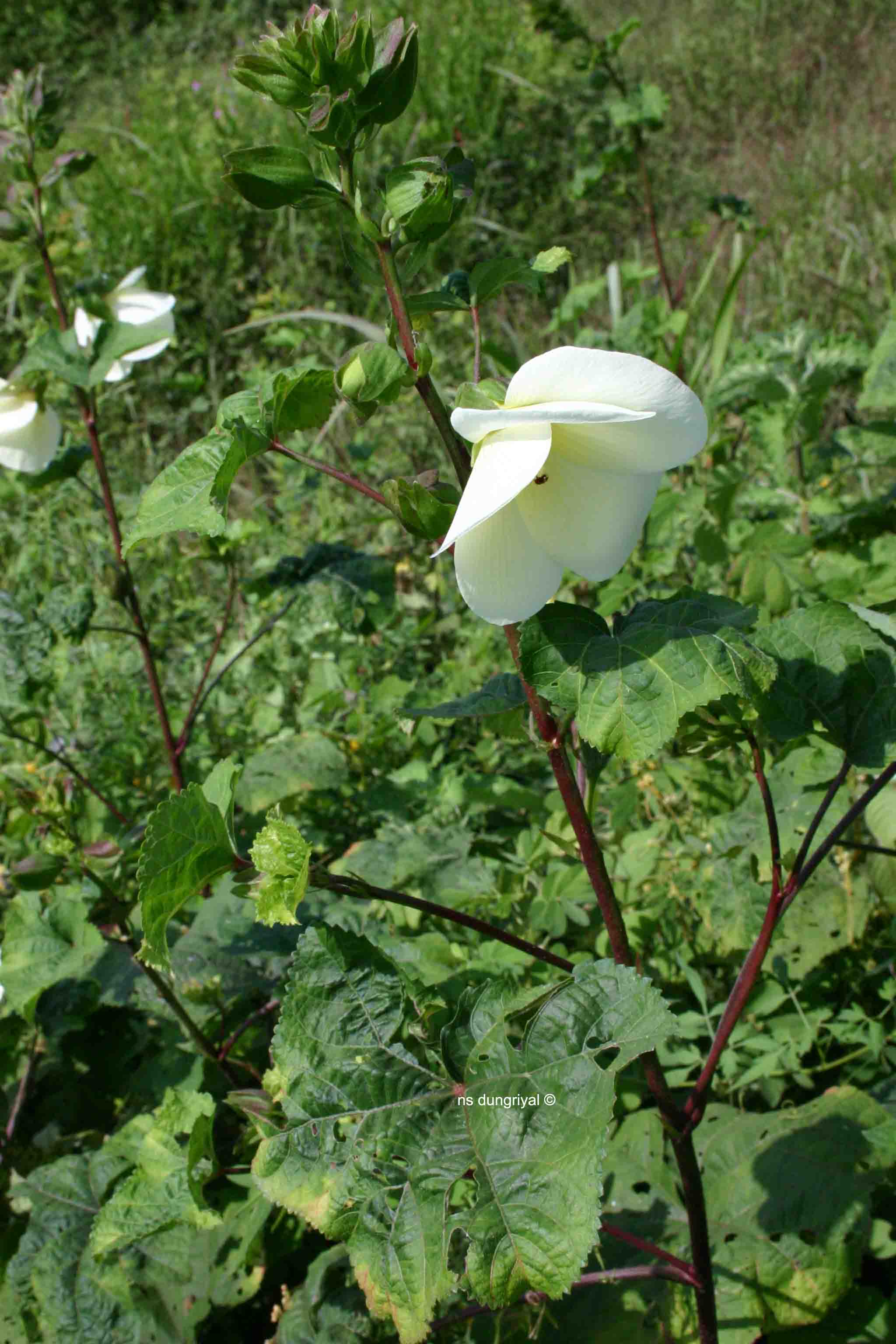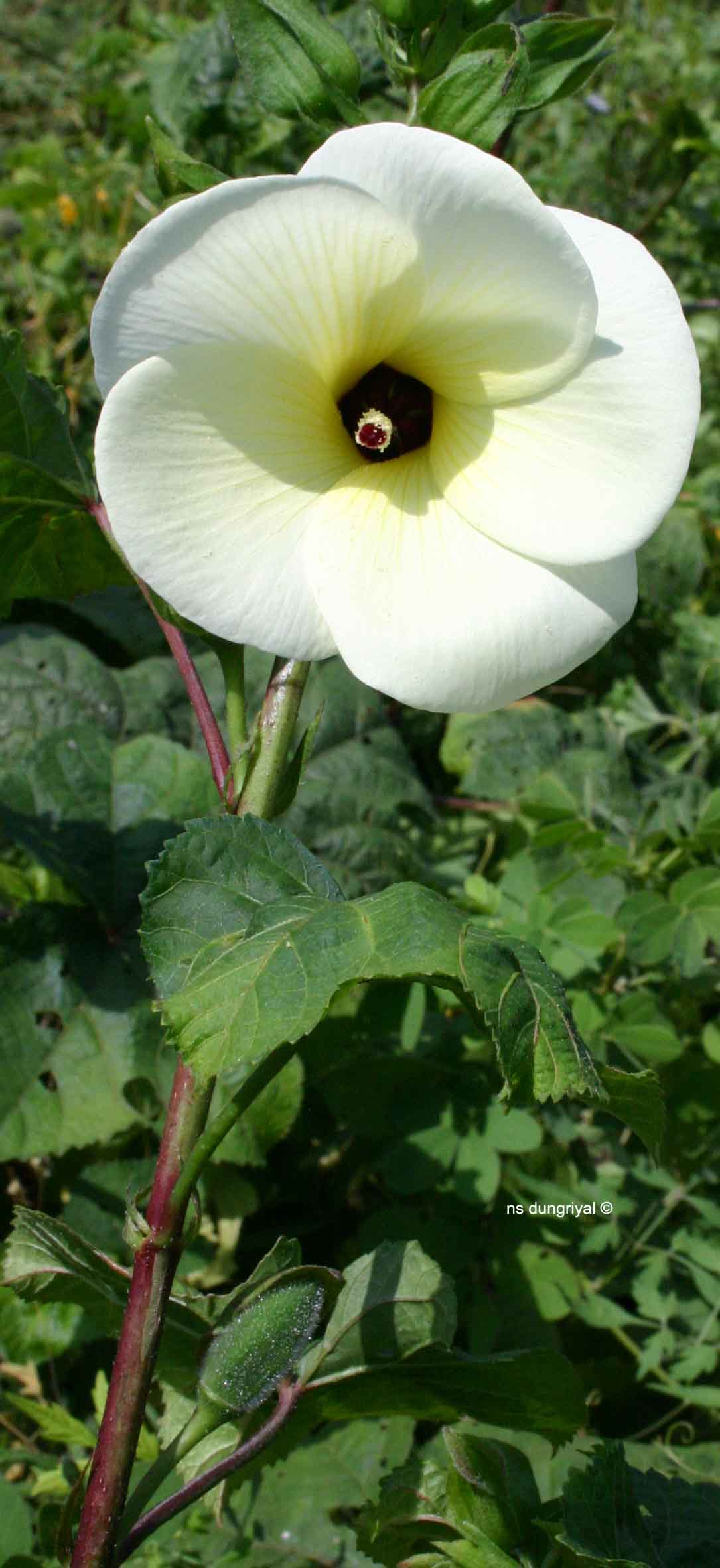|
Abelmoschus manihot subsp. tetraphyllus (Roxb. ex Hornem.) Borss.Waalk., Blumea 14: 97 1966. (Syn: Abelmoschus luzonensis Merr.; Abelmoschus mindanaensis Warb.; Abelmoschus tetraphyllus (Roxb. ex Hornem.) Wall.; Abelmoschus warreensis Dalz.; Erebennus canaranus Alef.; Hibiscus canaranus Miq. ex Mast.; Hibiscus tetraphyllus Roxb.; (≡) Hibiscus tetraphyllus Roxb. ex Hornem.);
.
As per efi thread:
Stem non – prickly = A. manihot subsp. manihot (Himalayan subsp.)
Stem prickly = A. manihot subsp. tetraphylla —->
subsp. tetraphylla var. tetraphylla …….epicalyx lobes covered with small soft hairs
subsp. tetraphylla var. pungens …….epicalyx lobes covered in long prickly hairs.
Point worth mentioning is, like many many species of the family, flowers bloom in the morning light yellow to yellow,
they turn pink by evening. Literature I perused, I got this hint that even learned people have confusion on flower color.
Leaf shape is very variable and doesn’t matter in ID process ……leaves are dark green, entire to variably lobed ……it is the epicalyx…broad, long, red …beautiful …prominently displayed on top of branches …. key to ID …….epicalyx lobes fall in fruit …….it is persistent in fruit in A. angulosus.
(Abelmoschus is separated from Hibiscus on basis of calyx…splits on one side in flowering, falls off with corolla on withering)
.
India: Throughout; Pakistan, Indo-China, China, Malesia and N. Australia as per BSI Flora of India;
.
India (Rajasthan, Gujarat, Maharashtra, Karnataka, Kerala), Malesia, New Guinea, Bismarck Arch. (New Ireland), Australia (Queensland), Myanmar [Burma] (Bago), Nepal, Philippines (Luzon, etc.) as per Catalogue of India;
.
Wild flower ID request – RK32 – 26-Oct-2012: Hibiscus tetraphyllus. Since all species of Section Abelmoschus have been transferred to Genus Abelmoschus, so the plant should be named as Abelmoschus tetraphyllus tetraphyllus Wall. ex Hornem. or if we follow The Plant List then Abelmoschus manihot subsp. tetraphyllus (Wall. ex Hornem.) Borss. Waalk., Blumea 14: 97, 1966. It is reasonable to follow latter. Plz id this wild plant: pa9 – 26oct2012:
This wild flower is clicked from Yeoor area … the plant is around 7 foot height. I saw a similar looking flower identified as some Hibiscus species in a recent post. Plz id this plant if it is possible. This plant has already featured today. It is the Wild Ladies’ Finger [Hibiscus tetraphylla]. If this plant is Hibiscus tetraphyllus then the correct name should be Abelmoschus manihot subsp. tetraphyllus as indicated in another thread. Sending some of my photographs taken on my property at Shahapur over the last few weekends. Attachments (7) I also know it as Abelmoschus manihot subsp. tetraphyllus, but yesterday … referred to it as Hibiscus tetraphylla, so I presumed that is the new name. My previous post and discussion on this are available at this link I wish we had some photographs with calyx and epicalyx in focus, because the plant is differentiated from cultivated lady’s finger (Abelmoschus esculentus in few (less than 6 as against more than 6) and larger broadly ovate epicalyx (5-10 mm broad as against less than 4 mm) and shorter more strongly hispid fruits. See if these images are what you are looking for …, ignore the labels. I would say second and third are A. esculentus only if this picture of A. manihot subsp. tetraphyllus is correct To me there seems to lot of confusion on the net. Some prominent photographs of Abelmoschus manihot subsp. tetraphyllus on the net do not seem to be matching the description in books or efloras. To me these may not belong to Abelmoschus looking at the small calyx.
Only authentic pectures which bring out the differences between A. esculentus and A. manihot subsp. tetraphyllus and match with the description of latter are on this page of Wikipedia and others
Strange but true perhaps Both above links of Hibiscus tetraphyllus which I doubted, to me actually may be Thespesia lampas. Here are the links again.
And yes the first photograph of … shows these broader epicalyx of Abelmoschus manihot subsp. tetraphyllus, clearly.
Hibiscus ID request – RK65 – 18-Dec-2012: Request identification of the species of this Hibiscus seen in Tungareshwar. The plant is about 2 feet tall. There was only one flower and no leaves. This is the Wild Ladies’ Fingers [Abelmoschus manihot ssp. tetraphylla]. My photographs of this are available at this link
Requesting ID of this plant – Mumbai – October 2013 :: 15022014 :: ARK-08: Attachments (3). 4 posts by 3 authors. Abelmoschus manihot subsp. tetraphyllus. Supporting …
incredible Abelmoschus from Hooghly: If i knew epicalyx was also very important to ID a plant i would have more concentrated on it, instead of flowers or leaves or fruits!
Species : Abelmoschus manihot var. pungens (Roxburgh) in FoC or Abelmoschus pungens (Roxb.) Voigt in FoP ???
Habit & Habitat : wild herb in a wasteplace beside railway tracks; about 5 to 7 feet tall; don’t have other figures
Date : 20/10/12, 12.30 p.m.
Place : Hooghly
Flower stat… Abelmoschus manihot subsp. tetraphyllus. If we want to go further it would be var. tetraphyllus and not pungens, as there are no prickly hairs on the epicalyx. I could get hold of its flower only and the same or part thereof was itching. I thought itching = prickly = pungens. As per FoC Abelmoschus manihot subsp. tetraphyllus var. tetraphyllus is found in Indonesia and Phillippines. As per Haines, Prain, Roxburgh and Hooker this should be Hibiscus pungens Roxb. Even though I fully accept that … is last word on Malvaceae as in many many other families I would request Gurcharan Sir to review one more time and give his final verdict. My points of dissent are –
Attached here relevant entries, and some related photographs.
While some authors like to treat all of the above as a single entity others differ as far as my google search informs.
Attachments (10)
Well, …, again I accept … silence as equivalent to hesitation. Let this species remain Abelmoschus manihot only, but please no ssp. tetraphyllus. Thanks, …, Can we keep it as Abelmoschus manihot (L.) Medik. subsp. tetraphyllus (Roxb. ex Hornem.) Borss. Waalk. var. pungens (Roxb.) Hochr. ? in efi as per GRIN till issue is finally resolved ? I think yes, … The attached pages from Flora of India (1993) may have some help. Attachments (2) Thank you very much Sir. Flora of India pages tell me that this species is either subsp. manihot or subsp. tetraphyllus var. pungens. Now, it is hard to tell which one of the above two this species can be. I found this beside railtracks, so there is less possibility of this plant to be an escape from cultivation. More so because the closest housing complex at that place is at least 200 m away. Moreover, the KEY, about presence/absence of prickly hairs, in the Flora of India you have attached herewith, goes against the notes under subsp. manihot. So, confusion remains.
But, I thank you again, very much, for the paper.
Feb2015sk11 Hooghly – Hibiscus tetraphyllus Roxb.? : 2 posts by 1 author. Attachments (8) This is Hibiscus tetraphyllus Roxb., the current accepted name of which might be Abelmoschus manihot subsp. tetraphyllus. I don’t have photographs, but have stats now, of leaves and fruits.
Thank you Wild Ladies’ Fingers, Abelmoschus manihot spp. tetraphyllus : 8 posts by 6 authors. Attachments (5) I have never seen this variety before … does the leaf shape distinguish this subsp. (from Abelmoschus manihot) ? I have seen the last picture before-Blyth’s Reed Wabbler. Good question ! In the classification of Abelmoschus in his ‘Flora of Maharashtra’ Vol 1, Dr.Almeida also lists the following :
– A.manihot
– A.manihot ssp. tetraphylla
– A manihot ssp. tetraphylla var. pungens
– A manihot ssp. tetraphylla var. megaspermus
Will take some time for me to figure this out. Meanwhile if someone else is willing to take the call …… I dont have this part of Flora of Maharastra so just asking out of curiosity, are these taxa named by Dr. Almeida himself? Here are few
A. manihot subsp manihot A. manihot ssp. tetraphylla
Plants glabrous, Plants hispid, slightly prickly
Petiole 12-15 cm long Petiole about 6-8 cm long
Leaf lobes linear-oblong, coarsely toothed or lobulate Lobes lanceolate, crenate-toothed
Flowers about 12 cm across Flowers about 6 cm across Many thanks … for providing the differences … now will look out for these, the next meeting this plant(s).
Going through them makes me feel that most of the instances, must have overlooked the differences and generalized it to just A. manihot. Is it Thespesia lampas as per earlier thread ? … this is Abelmoschus manihot … commonly known as: edible hibiscus, manihot-mallow, sunset hibiscus, yellow hibiscus • Assamese: usipak • Gujarati: કાંટાલૉ ભેંડે kantalo bhende • Hindi: जंगली भिंडी jungli bhindi • Marathi: रान भेंडी raan bhendi BSI Flora of India says that subsp. manihot is mainly cultivated in southeast Asia and sometimes occurs as an escape from cultivation, while subsp. tetraphyllus (Roxb. ex Homem.) Borss. is distributed through out India. Taken at Maharashtra Nature Park,Mumbai, Maharashtra on 19/9/10.
Found growing wild Plant around 4-5 feet with Yellow flowers. This is the Wild Ladies’ Fingers [Abelmoschus manihot]. Please check this link for my photographs of this : BSI Flora of India says that subsp. manihot is mainly cultivated in southeast Asia and sometimes occurs as an escape from cultivation, while subsp. tetraphyllus (Roxb. ex Homem.) Borss. is distributed through out India.
Malvaceae Fortnight :: Abelmoschus manihot :: Thane :: DVJUL07 : 1 post by 1 author. 7 images. BSI Flora of India says that subsp. manihot is mainly cultivated in southeast Asia and sometimes occurs as an escape from cultivation, while subsp. tetraphyllus (Roxb. ex Homem.) Borss. is distributed through out India.
In view taking this as subsp. tetraphyllus (Roxb. ex Homem.) Borss.
. Malvaceae week :: Abelmoschus manihot: Abelmoschus manihot (L.) Medik.
a-bel-MOS-kus — from Arabic, abu-al-mosk (father, or source of musk)
MAN-ee-hot — from manioc, the Brazilian name for the plant [image: Abelmoschus manihot]<http://www.google.com/url?q=http%3A%2F%2Fwww.flickr.com%2Fphotos%2Fdi…> Aug 10, 2007 at Vaghbil, Thane
commonly known as: edible hibiscus, manihot-mallow, sunset hibiscus, yellow hibiscus • *Assamese*: usipak • *Gujarati*: કાંટાલૉ ભેંડે kantalo bhende • *Hindi*: जंगली भिंडी jungli bhindi • *Marathi*: रान भेंडी raan
bhendi Native to: China, Bhutan, India, Nepal, Pakistan, Malesia; widely cultivated in tropics
– [image: Abelmoschus manihot]<http://www.google.com/url?…>
… Nov 6, 2010 at Yeoor Hills, Thane – [image: Abelmoschus manihot]<http://www.google.com/url?q…> … Nov 6, 2010 at Yeoor Hills, Thane – [image: Abelmoschus manihot]<http://www.google.com/url?q=http%…> … Nov 6, 2010 at Yeoor Hills, Thane – [image: Abelmoschus manihot]<http://www.google.com/url?q=h…> … Sep 18, 2010 at Vaghbil, Thane – [image: Jungli Bhindi (Hindi: जंगली भिंडी)]<http://www.google.com/url?q=ht…> … Aug 24, 2007 at Vaghbil, Thane BSI Flora of India says that subsp. manihot is mainly cultivated in southeast Asia and sometimes occurs as an escape from cultivation, while subsp. tetraphyllus (Roxb. ex Homem.) Borss. is distributed through out India.
In view taking this as subsp. tetraphyllus (Roxb. ex Homem.) Borss. Malvaceae week: Abelmoschus manihot from Arunachal_RKC06_090911: Abelmoschus manihot ssp tetraphyllus Loc.: Tuting, Upper Siang district, Arunachal Pradesh (ca 700m)
Date: Nov. 2007 Locally called as ‘Hidum Tapyak’ by Adi tribes. Thanks for sharing Jungli Bhindi
Malvaceae week : Abelmoschus manihot
Growing wild in open area in Pune city. Beautiful flower. What satin look, BSI Flora of India says that subsp. manihot is mainly cultivated in southeast Asia and sometimes occurs as an escape from cultivation, while subsp. tetraphyllus (Roxb. ex Homem.) Borss. is distributed through out India. Seeds for ID 210812 NB4 : in my last trip to india dec.11-jan.12 I collected some seeds in capsules. There are two sorts of capsules and the seeds are mixed up. Azanza lampa and abelmoschus manihot Abelmoschus manihot – MN200912: Attachments (1). Abelmoschus manihot BSI Flora of India says that subsp. manihot is mainly cultivated in southeast Asia and sometimes occurs as an escape from cultivation, while subsp. tetraphyllus (Roxb. ex Homem.) Borss. is distributed through out India.
Abelmoschus manihot—for sharing and validation : Attachments (1). 1 post by 1 author. Pic of Sweet Hibiscus taken at Ambyvalley rd. lonavala/mulshi, pune in oct12. BSI Flora of India says that subsp. manihot is mainly cultivated in southeast Asia and sometimes occurs as an escape from cultivation, while subsp. tetraphyllus (Roxb. ex Homem.) Borss. is distributed through out India. Requesting ID of this plant with pale yellow flowers – Abelmoschus? – Mumbai :05072013 : ARK-02 : September 2012 : Attachments (3). 7 posts by 5 authors. Azanza lampus The leaf structure looks different… Yes. It is Azanza lampus from Malvaceae. Resembles to Bhindi ( Lady’s fingers) flowers and somewhat Thespesia populnea flowers. Hence may be called “रानभेंडी” in Marathi Thank you … for the links and the ID… I gather from the links that this is Abelmoschus manihot…
BSI Flora of India says that subsp. manihot is mainly cultivated in southeast Asia and sometimes occurs as an escape from cultivation, while subsp. tetraphyllus (Roxb. ex Homem.) Borss. is distributed through out India. Abelmoschus manihot—for sharing and validation : 1 post by 1 author. Attachments (3) BSI Flora of India says that subsp. manihot is mainly cultivated in southeast Asia and sometimes occurs as an escape from cultivation, while subsp. tetraphyllus (Roxb. ex Homem.) Borss. is distributed through out India. Malvaceae Fortnight :: Abelmoschus manihot ::Mumbai:: PKAJUL28 :: : 1 post by 1 author. Attachments (2) Malvaceae fortnight :: Abelmoschus manihot :: Pune: SMP03 : 2 posts by 2 authors. 2 images. wonderfully clear and precise photography
appreciate it much BSI Flora of India says that subsp. manihot is mainly cultivated in southeast Asia and sometimes occurs as an escape from cultivation, while subsp. tetraphyllus (Roxb. ex Homem.) Borss. is distributed through out India. Abelmoschus for ID :: Mumbai :: ARKMAR-03 : 6 posts by 3 authors. Attachments (5) efi page on Abelmoschus manihot I too think it must be Abelmoschus manihot. BSI Flora of India says that subsp. manihot is mainly cultivated in southeast Asia and sometimes occurs as an escape from cultivation, while subsp. tetraphyllus (Roxb. ex Homem.) Borss. is distributed through out India. Names of Plants in India :: Abelmoschus esculentus: 2 posts by 2 authors. 1 image. Illustrated photo at base village Vadgaon of Manikgad, 11 SEP 2011 To me image looks more closer to images at Abelmoschus manihot subsp. tetraphyllus (Roxb. ex Hornem.) Borss.Waalk. (with three varities) rather than those at Abelmoschus esculentus (L.) Moench Thanks … for validating the post; requesting for further validation … Thanks, …
Posted images now are fine.
In your original image in this thread, epicalyx appears to be 4 or 5 and these are much broader as in your 2nd image of Abelmoschus manihot subsp. tetraphyllus (Roxb. ex Hornem.) Borss.Waalk. Thanks very much for the validation Due to onset of the new Google Sites, and eventual sunset of the classic Google Sites, I am moving my data from the existing Names of Plants in India to Google’s Blogger. I hope this solution will not let me down again. Thus, my work will now assume shape of a blog for every plant whose names I will gather / compile. One sample blog on Abelmoschus esculentus (L.) Moench for your view.
I have to migrate about 600 odd plants that I had already compiled, to this Blogger, before I set out for new compilations. I hope I will be able to manage it before sunset of classic Google Sites.
Thanks, … Hope for a nice transition. Nice shot.. ..!! Actually the leaf and fruit morphology played important role here
Abelmoschus? : 5 posts by 2 authors. Attachments (1) I have since come to know that it is edible and that it’s a fairly long lasting shrub.
No idea about the Botanical name, though. yes i in namakkal, trichy areas of tamilnadu cultivating for home use. they will call us naatu vendankka (Abelmoschus longifolius (Willd.) ) modern peoples not liking this variety because it has more amount mucus like substance in culnary. after harvesting we can’t store for week. because it will mature fastly. so people they will cut and dry it sunlight. it reduce mucus like substance in sambar and also prevent maturing. nowdays we cannot see this natural cultivar because dominating hybirds varieties Thank you, … Will save the seeds and try to popularise it since you say it’s disappearing. Thanks also for the tips on drying it. very interesting, …
Even in varieties we buy there are some that are more mucousy than others… i imagine a little drying under the fan in the home would perhaps be similar i imagine??? and in village markets they do sell several different seeds, i was wondering if they are all hybrids?
I think more closer to images at Abelmoschus manihot subsp. tetraphyllus (Roxb. ex Hornem.) Borss.Waalk.
Date/Time : 13th of October, 2009/ 2.11 pm
Location Place : Shahapur,Maharashtra … Altitude : … GPS : Habitat : Wild … Type : Plant Habit : Herb … Height : 3-4 feet … Length : Leaves Type : … Shape : as seen … Size : Inflorescence Type : … Size : Flowers Size : about 2 inches … Colour : light pink Found growing in the wild by the roadside. There were many of them.
Is this Jangli Bhendi? the plant in the attached photo is ………………………… Abelmoschus esculentus (Linnaeus) Moench
I am familiar with Lady’s Finger…those flowers are Lemon coloured and not Pink. will send a picture taken at Maharashtra Nature Park in a diff post. Just give a search in google with “Abelmoschus esculentus” and see the images, thousand of images will come all have yellow flowers …………its a surprise you will happy. I agree with …, I have seen both. Incidentally, I have eaten the fruits growing wild too. It tastes just like Lady’s finger. I wonder if you could call it
Jungli Bhendi. Date: 05/02/11
Time: 05:44 PM Picture taken near Vembrand Lake, Kumarakom Bird Sanctuary, Kerala. – … but for the colour, almost looks like Abelmoschus manihot. – Abelmoschus manihot indeed BSI Flora of India says that subsp. manihot is mainly cultivated in southeast Asia and sometimes occurs as an escape from cultivation, while subsp. tetraphyllus (Roxb. ex Homem.) Borss. is distributed through out India. Fwd: pls help me in identifying these plants- Mew 111015- 2 : 2 posts by 2 authors. Attachments (3)- each 1 MB or more
This one may be Kasthuri bendi Looks like Abelmoschus moschatus to me too. I think closer to images at Abelmoschus manihot subsp. tetraphyllus (Roxb. ex Hornem.) Borss.Waalk. The Bengali name for Hibiscus mutabilis is STHALPADMA and i have seen it shrub occasionally. But does it have okra like fruit? The attached pictures are of a herb, much smaller than STHALPADMA
Species : Hibiscus mutabilis L. ???
Habit & Habitat : wild herb, about 2 ft., uncultivated land
Date : 17-03-12, 9.54 a.m.
Place : Gobra (Hooghly), WB Negative. This looks like Kasturi bhendi an ayurvedic herb Abelmoschus moschatus Thank you very much for the ID of this plant. Taking cue from you i have found description and images at – http://toptropicals.com/cgi-bin/.
Also learned that these flowers can be yellow also.
Later in order to take more photographs i visited that particular place a number of times but the plant seemed to be vanished. I also searched the surrounding area, there was no trace of a second individual. besh bhalo argument and link… Check out this link I have noticed the differences, last night, but then i thought it might be had been resulted from
Many a times i have noticed marked differences in leaf shapes & surface textures of Ipomoea aquatica and I. marginata. But, then it might also be some other Abelmoschus sp. At least we have some clue now. Please also check –
However, attaching two uncropped images of the same plant for your perusal. Thank you once again for the link and more information on the plant. I fail to find much data/images from Indian subcontinent so that i could compare the varieties, if available. Today i visited the place once again. Found three saplings, 6 to 8 inches high, that i think of the same species. But, before i proceed please let me give a bit more details of those saplings. Those three saplings were planted in line with a gap of about 2 ft each. It is as if they were planted by someone, but only three?!
Attaching the images of leaves from those plants/saplings. Please note :-
One seller is selling a plant named “Hibiscus abelmoschus sagittifolius” – http://www.ebay.com/itm/Hibiscus-abelmoschus-sagittifolius-Salmon-Pink-Flowers-Caudiciform-10-seeds-/170843422874 !!! Well, it was for science only, in no way for promoting the seller 🙂 I am very sorry to say that those saplings, pictures attached here, are not Abelmoschus moschatus. I visited those saplings again and noticed that they have grown to blooming Hibiscus vitifolius L. as in – efi thread. … :((
Though the second set of pictures of the saplings turned out to be another species, the plant featuring in the original post is surely Abelmoschus moschatus Medik., as have been identified by … I think closer to images at Abelmoschus manihot subsp. tetraphyllus (Roxb. ex Hornem.) Borss.Waalk.
efloraofindia:” is this some wild Hibiscus at Talegaon Dabhade :Dec 2015: MR-08 : 3 posts by 2 authors. Attachments (2) Talegaon Dabhade Pune
Dec 2015
Requesting to Id this wild straggler I think. is it some Hibiscus species? Must be Abelmoschus manihot, not sure why growing prostrate.
Please wait for comment(s). Yes, appears close to images at Abelmoschus manihot subsp. tetraphyllus (Roxb. ex Hornem.) Borss.Waalk. Flower ID Request 20111006: Abelmoschus mannihot may be Pl also check it for Abelmoschus ficulneus. I think close to images at Abelmoschus manihot subsp. tetraphyllus (Roxb. ex Hornem.) Borss.Waalk.
Identification no 131013sn1 : Attachments (1). 2 posts by 2 authors. I am not sure if this can be identified. I have just one photo, shooting out from a large field of Karvi.
date/time”oct12
location:ambyvalley rd.,lonavala,pune
habitat:wild
plant habit:?
height:about 4-5 ft. … looks like species of Abelmoschus. Though not clear appear close to images at Abelmoschus manihot subsp. tetraphyllus (Roxb. ex Hornem.) Borss.Waalk.
Pl. post original image for confirmation. attaching more photos which i think is Abelmoschus manihot subsp. tetraphyllus Yes I agree but of a different plant.
Date/Time- 30/5/2011- 09 AM
Location- Place, Altitude, GPS- Assam, May be Abelmoschus moschatus Surely Abelmoschus,, but flowers are not clear to id species. I think close to images at Abelmoschus manihot subsp. tetraphyllus (Roxb. ex Hornem.) Borss.Waalk. Location Kalimpong Darjeeling West Bengal
Please identify
Could not match with any Hibiscus species as per comparative images at /species/m—z/m/malvaceae/hibiscus Just check it for Fioria vitifolia (L.) Mattei (Hibiscus vitifolius L.)
Does not match with images at Hibiscus vitifolius
May be some Abelmoschus species.
Gossipium or the cotton plant.
Gossypium sp
Does not match with any species we have so far in efi as below:
I think appears close to images at Abelmoschus manihot subsp. tetraphyllus (Roxb. ex Hornem.) Borss.Waalk. SGNP, Sep 2014 :: Requesting ID of this plant :: ARKOCT-02 : 6 posts by 3 authors. Attachments (1). efi page on Abelmoschus manihot Abelmoshatus spp ? Possible, closeups of calyx, epicalyx or rear view of the flower would have helped to confirm. Thanks … I try to have better views, but if one is in a group, then it becomes a bit difficult…… Appears closer to images at Abelmoschus manihot subsp. tetraphyllus (Roxb. ex Hornem.) Borss.Waalk.
Abelmoschus maniho subsp. tetraphylla var. tetraphylla : 4 posts by 3 authors. Attachments (28)
Long name !! Two days ago got this query.
Spent some time over it and found the key !
In simple words …
Stem non – prickly = A. manihot subsp. manihot (Himalayan subsp.)
Stem prickly = A. manihot subsp. tetraphylla —->
subsp. tetraphylla var. tetraphylla …….epicalyx lobes covered with small soft hairs
subsp. tetraphylla var. pungens …….epicalyx lobes covered in long prickly hairs.
Specimen I collected in Surat today (14 10 2019) morning is definitely Abelmoschus manihot subsp. tetraphylla var. tetraphylla !
Point worth mentioning is, like many many species of the family, flowers bloom in the morning light yellow to yellow,
they turn pink by evening. Literature I perused, I got this hint that even learned people have confusion on flower color.
Leaf shape is very variable and doesn’t matter in ID process ……leaves are dark green, entire to variably lobed ……it is the epicalyx…broad, long, red …beautiful …prominently displayed on top of branches …. key to ID …….epicalyx lobes fall in fruit …….it is persistent in fruit in A. angulosus.
(Abelmoschus is separated from Hibiscus on basis of calyx…splits on one side in flowering, falls off with corolla on withering)
Use …..to clean Jaggery ….it is crushed along with sugarcane !!! Age old technique of farmers all over India. Sorry for spelling mistake in subject. you are a true blue researcher, …
do this for medical problems in Gujarat
I am convinced you will make definite inroads to solving some Please help to identify this Abelmoschus : 3 posts by 2 authors. Attachments (5)- including 2 mb and 3 mb images.
Please help to identify this Abelmoschus 16 October 19
Agra, U.P Abelmoschus manihot subsp. tetraphylla var. tetraphylla
Malvaceae for ID : Nasik : 28SEP21 : AK – 052: 4 images. Abelmoschus ficulneus The one suggested by you has white flowers.
Please check.
This looks different No ma’am, this is also same, whe flower freshly opened like this, observe the same flower definitely that will change as white after mature, and
when under shade and fully moisture content available flower will Creamish or Yellowish white
When fully sun exposed and less minerals flower will be purely white,
I have observed these both. and
Even purely pink, yellow, dark blue flowers also will be in white, that color depends on edaphic factors . But still it is a little difficult to be convinced.
Since both look much different. Ok ma’am, if possible share earlier plant photos too here, Adding pictures of what has been identified on the group or by me as Abelmoschus ficulneus. Will you provide data as our EfI format for both species Frankly I don’t know what you mean by providing data in Efi format.
I am not an expert in this field and my approach is always casual in finding out the names of plants that I have clicked.
My identification of the pictures I have added subsequently (White flowers) is only based on my earlier post, other posts on Efloraofindia, Flowersofindia and other images available on Google search. It’s OK ma’am, I mean plant data,
where you have collected ex. moist area, dry area, along the road(Habitat), habit (shrub, or herb) either prostrate or erect, height, flowers single or inflorescence tye, about fruit, seeds data only ma’am,
with that information, we will finalize the species, It was a very small plant by the roadside.
Gangapur Dam is in Nasik.
The area around is known as the Gangapur Grasslands.
I saw this small plant growing near the water body in the grass.
No seed formation as yet. Ok ma’am, I will watch out for the fruits/seeds. I think this is Abelmoschus manihot subsp. tetraphyllus (Roxb. ex Hornem.) Borss.Waalk. var. tetraphyllus Adding images of similar plants behind a fence close by.
There were many, some of them about five feet in height.
5 images. .
Abelmoschus manihot subsp. tetraphyllus (Roxb. ex Hornem.) Borss.Waalk. var. tetraphyllus . Abelmoschus manihot subsp. tetraphyllus (Roxb. ex Hornem.) Borss.Waalk.: For what ? . Abelmoschus manihot (L.) Medik. :: Waghbil, Thane, Maharashtra :: Sep 19, 2009 · 3:48 PM IST: 1 image. . Abelmoschus manihot (L.) Medik. :: Waghbil, Thane, Maharashtra :: Sep 18, 2010 · 1:40 PM IST: 1 image. What about the closeup of flowers. It would be nice if you post them. This observation, the familiar plant was in fruiting.
I do have photos of flowers of some other observations, which I will eventually upload. Yes, as per images at . Abelmoschus manihot (L.) Medik. :: Waghbil, Thane, Maharashtra :: Sep 18, 2010 · 1:30 PM IST: 2 images. It is https://efloraofindia.com/2012/11/02/abelmoschus-manihot-subsp-tetraphyllus/ . Abelmoschus manihot subsp. tetraphyllus (Roxb. ex Hornem.) Borss.Waalk.
Waghbil, Thane, Maharashtra :: Sep 20, 2008 · 12:59 PM IST :: about 3 m (10 ft) asl
Earlier uploaded at efloraofindia . Abelmoschus manihot subsp. tetraphyllus (Roxb. ex Hornem.) Borss.Waalk. :: Waghbil, Thane :: Aug 24, 2007 · JUN23 DV345: 1 image. . Abelmoschus manihot subsp. tetraphyllus (Roxb. ex Hornem.) Borss.Waalk. :: Waghbil, Thane :: Aug 10, 2007 · JUN23 DV349: 3 images.
Hibiscus vitifolius L from Satpura – NSD 7 : 9 posts by 5 authors. Attachments (2) it was near agriculture field
i think it is Hibiscus vitifolius L
experts please comment
…, I think it may be not H. vitifolius.
I am attaching few photos of what I am considering as H. vitifolius (syn. of Fioria vitifolia).
I may be wrong; will as well get validated. It looks Ablemoschus manihot to me. Pl. check. yes you are right, my plant is not H. vitifolius, but your seems to be correct as per the detail of Flora of Pachmari & Bori Reserves published by BSI. The main id character seems to be Capsule 5 winged hairy. I searched my old pics and found some of them H. vitifolius, which i photographed on 17-9-08 (Last year). One pic is attached. Attachments (1) thanks for correcting my id, yes it looks like Ablemoschus manihot It may be Abelmoschus angulosus var. angulosus. I think it is Abelmoschus angulosus var angulosus. To me this appears close to images at Yes …, It’s not H. vitifolius. It’s Abelmoscus manihot only . Plant ID: SD05012: 3 high res. images. Here’s a photograph of the unripe fruit. Please check Abelmoschus angulosus Wall. ex Wight & Arn. . 151024KPD1: Regarding identification of the species collected from Khurda Odisha on October 24: 3 high res. images. Please check Abelmoschus angulosus Wall. ex Wight & Arn. . ID KNR 02/11/24: 1 image. Abelmoschus . https://efloraofindia.com/2011/02/01/abelmoschus/ But leaves are required for confirmation.
. References:
|
Abelmoschus manihot subsp. tetraphyllus var. tetraphylla
Updated on September 19, 2025

